Decision Making in Management
VerifiedAdded on 2023/01/20
|20
|5504
|23
AI Summary
This document discusses the concept of decision making in management and its importance in business. It explores a case study of British Airways and analyzes the organizational problems faced by the company. The document also discusses the theories of rational choice and strategic choice in decision making. It provides justification for the problem faced by British Airways and deconstructs the organizational problem using rational choice theory.
Contribute Materials
Your contribution can guide someone’s learning journey. Share your
documents today.
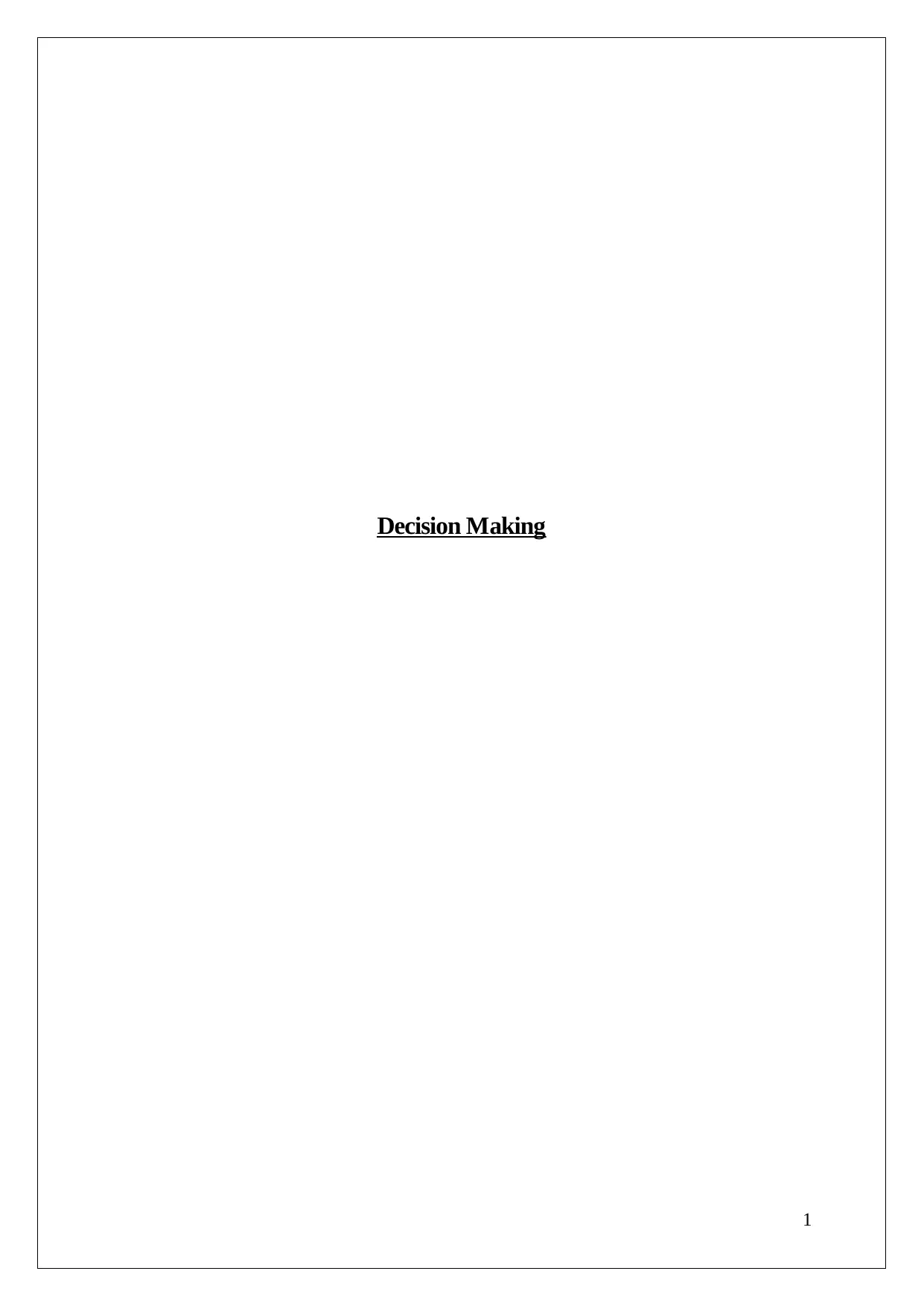
Decision Making
1
1
Secure Best Marks with AI Grader
Need help grading? Try our AI Grader for instant feedback on your assignments.
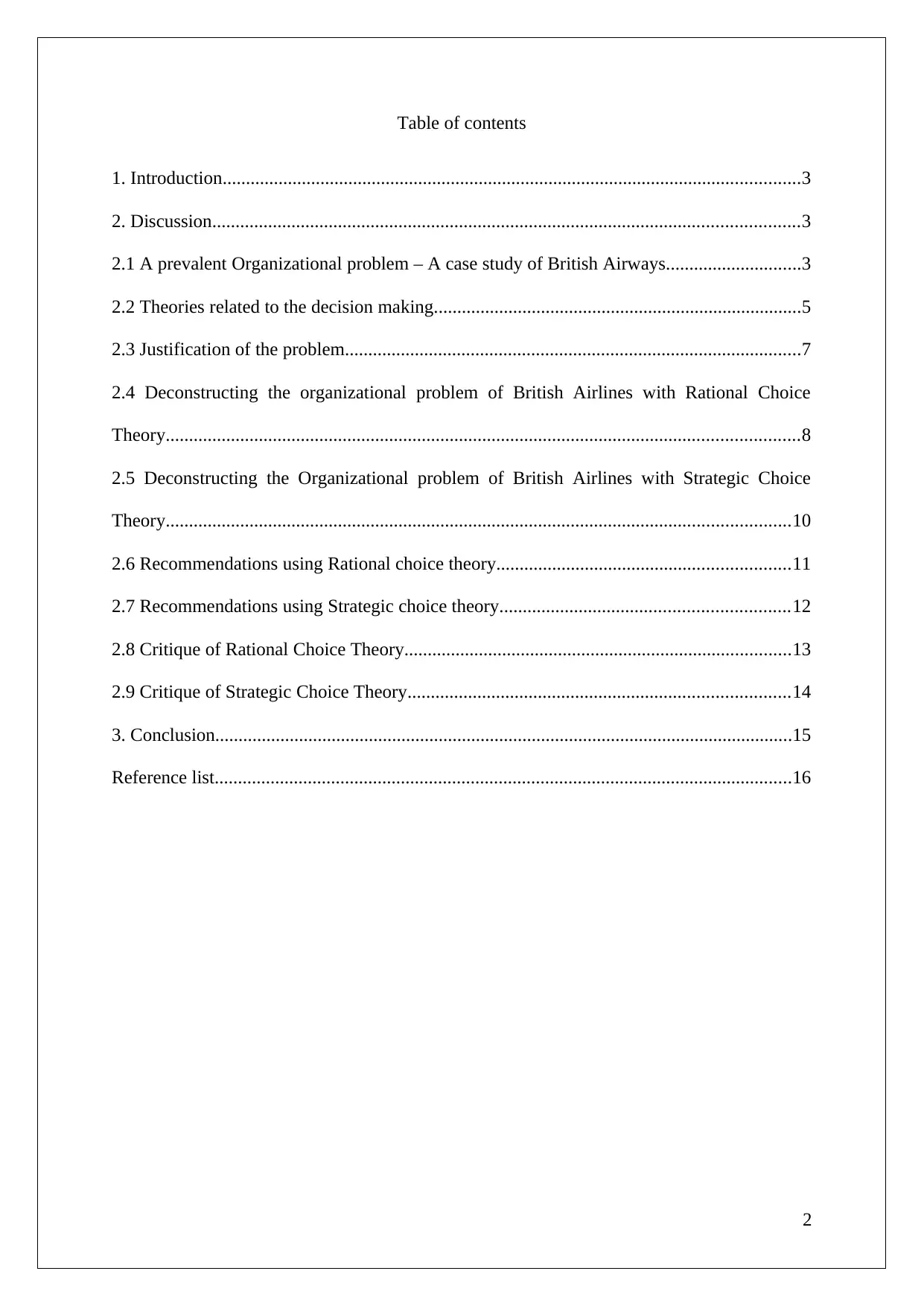
Table of contents
1. Introduction............................................................................................................................3
2. Discussion..............................................................................................................................3
2.1 A prevalent Organizational problem – A case study of British Airways.............................3
2.2 Theories related to the decision making...............................................................................5
2.3 Justification of the problem..................................................................................................7
2.4 Deconstructing the organizational problem of British Airlines with Rational Choice
Theory........................................................................................................................................8
2.5 Deconstructing the Organizational problem of British Airlines with Strategic Choice
Theory......................................................................................................................................10
2.6 Recommendations using Rational choice theory...............................................................11
2.7 Recommendations using Strategic choice theory..............................................................12
2.8 Critique of Rational Choice Theory...................................................................................13
2.9 Critique of Strategic Choice Theory..................................................................................14
3. Conclusion............................................................................................................................15
Reference list............................................................................................................................16
2
1. Introduction............................................................................................................................3
2. Discussion..............................................................................................................................3
2.1 A prevalent Organizational problem – A case study of British Airways.............................3
2.2 Theories related to the decision making...............................................................................5
2.3 Justification of the problem..................................................................................................7
2.4 Deconstructing the organizational problem of British Airlines with Rational Choice
Theory........................................................................................................................................8
2.5 Deconstructing the Organizational problem of British Airlines with Strategic Choice
Theory......................................................................................................................................10
2.6 Recommendations using Rational choice theory...............................................................11
2.7 Recommendations using Strategic choice theory..............................................................12
2.8 Critique of Rational Choice Theory...................................................................................13
2.9 Critique of Strategic Choice Theory..................................................................................14
3. Conclusion............................................................................................................................15
Reference list............................................................................................................................16
2
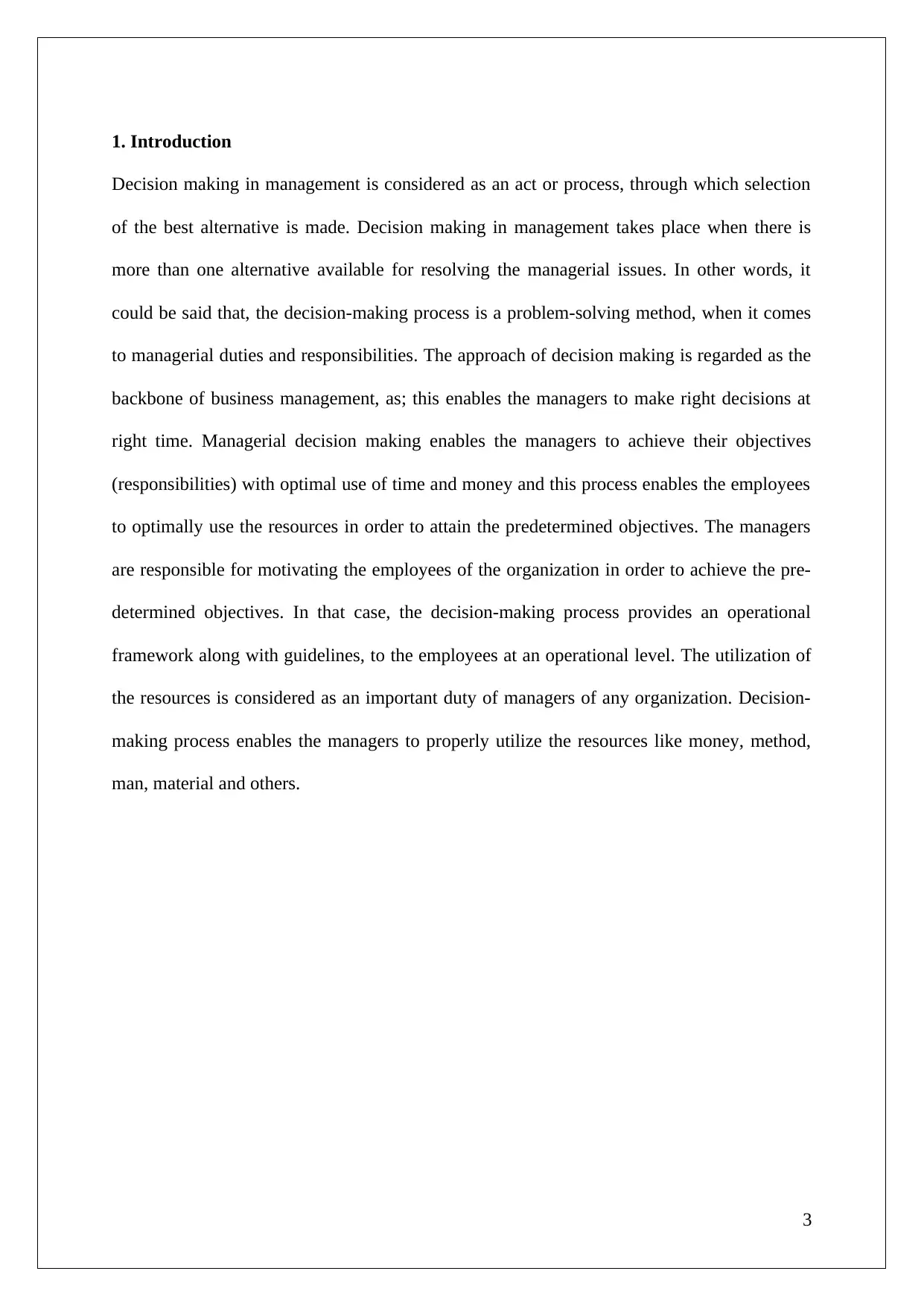
1. Introduction
Decision making in management is considered as an act or process, through which selection
of the best alternative is made. Decision making in management takes place when there is
more than one alternative available for resolving the managerial issues. In other words, it
could be said that, the decision-making process is a problem-solving method, when it comes
to managerial duties and responsibilities. The approach of decision making is regarded as the
backbone of business management, as; this enables the managers to make right decisions at
right time. Managerial decision making enables the managers to achieve their objectives
(responsibilities) with optimal use of time and money and this process enables the employees
to optimally use the resources in order to attain the predetermined objectives. The managers
are responsible for motivating the employees of the organization in order to achieve the pre-
determined objectives. In that case, the decision-making process provides an operational
framework along with guidelines, to the employees at an operational level. The utilization of
the resources is considered as an important duty of managers of any organization. Decision-
making process enables the managers to properly utilize the resources like money, method,
man, material and others.
3
Decision making in management is considered as an act or process, through which selection
of the best alternative is made. Decision making in management takes place when there is
more than one alternative available for resolving the managerial issues. In other words, it
could be said that, the decision-making process is a problem-solving method, when it comes
to managerial duties and responsibilities. The approach of decision making is regarded as the
backbone of business management, as; this enables the managers to make right decisions at
right time. Managerial decision making enables the managers to achieve their objectives
(responsibilities) with optimal use of time and money and this process enables the employees
to optimally use the resources in order to attain the predetermined objectives. The managers
are responsible for motivating the employees of the organization in order to achieve the pre-
determined objectives. In that case, the decision-making process provides an operational
framework along with guidelines, to the employees at an operational level. The utilization of
the resources is considered as an important duty of managers of any organization. Decision-
making process enables the managers to properly utilize the resources like money, method,
man, material and others.
3
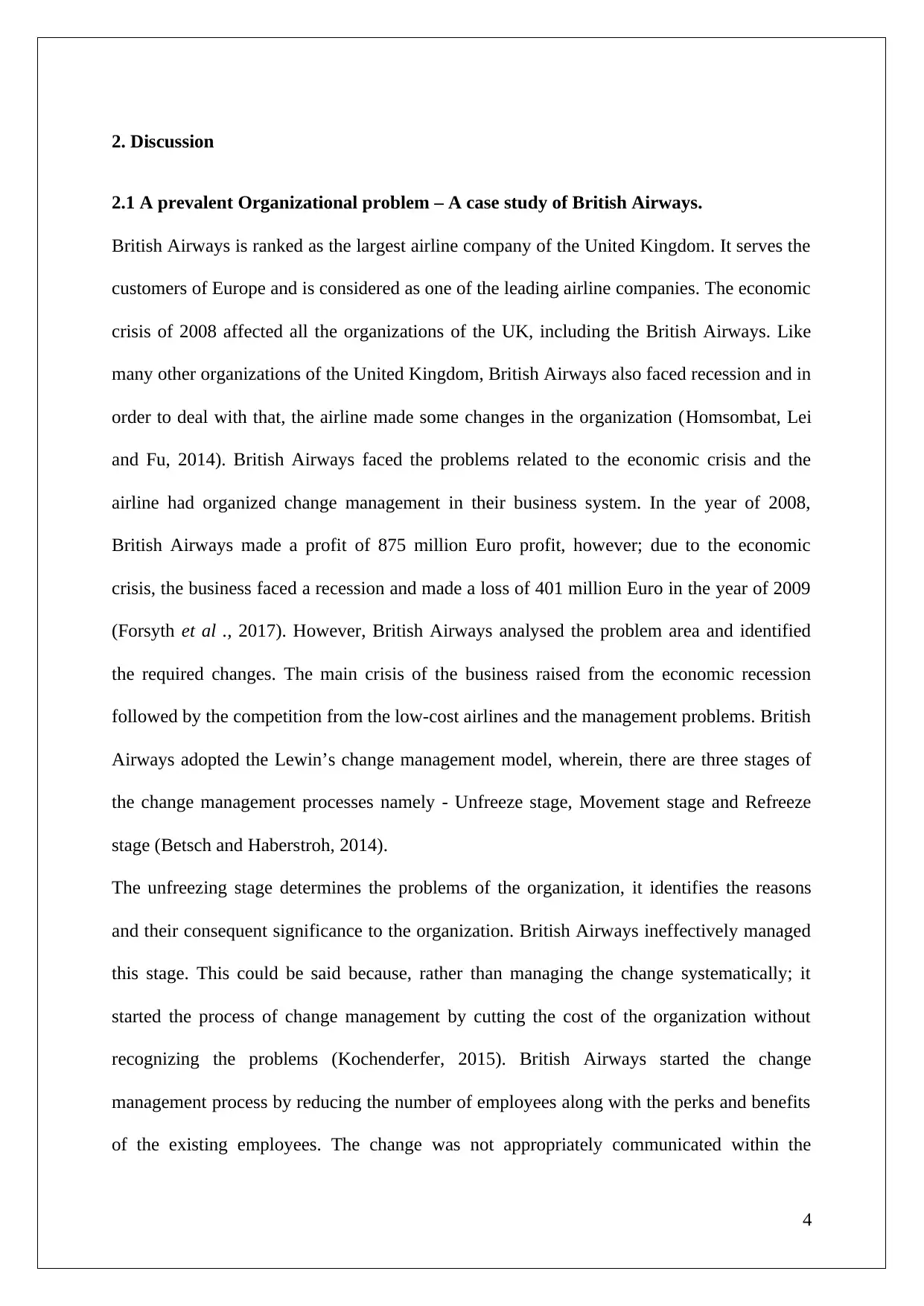
2. Discussion
2.1 A prevalent Organizational problem – A case study of British Airways.
British Airways is ranked as the largest airline company of the United Kingdom. It serves the
customers of Europe and is considered as one of the leading airline companies. The economic
crisis of 2008 affected all the organizations of the UK, including the British Airways. Like
many other organizations of the United Kingdom, British Airways also faced recession and in
order to deal with that, the airline made some changes in the organization (Homsombat, Lei
and Fu, 2014). British Airways faced the problems related to the economic crisis and the
airline had organized change management in their business system. In the year of 2008,
British Airways made a profit of 875 million Euro profit, however; due to the economic
crisis, the business faced a recession and made a loss of 401 million Euro in the year of 2009
(Forsyth et al ., 2017). However, British Airways analysed the problem area and identified
the required changes. The main crisis of the business raised from the economic recession
followed by the competition from the low-cost airlines and the management problems. British
Airways adopted the Lewin’s change management model, wherein, there are three stages of
the change management processes namely - Unfreeze stage, Movement stage and Refreeze
stage (Betsch and Haberstroh, 2014).
The unfreezing stage determines the problems of the organization, it identifies the reasons
and their consequent significance to the organization. British Airways ineffectively managed
this stage. This could be said because, rather than managing the change systematically; it
started the process of change management by cutting the cost of the organization without
recognizing the problems (Kochenderfer, 2015). British Airways started the change
management process by reducing the number of employees along with the perks and benefits
of the existing employees. The change was not appropriately communicated within the
4
2.1 A prevalent Organizational problem – A case study of British Airways.
British Airways is ranked as the largest airline company of the United Kingdom. It serves the
customers of Europe and is considered as one of the leading airline companies. The economic
crisis of 2008 affected all the organizations of the UK, including the British Airways. Like
many other organizations of the United Kingdom, British Airways also faced recession and in
order to deal with that, the airline made some changes in the organization (Homsombat, Lei
and Fu, 2014). British Airways faced the problems related to the economic crisis and the
airline had organized change management in their business system. In the year of 2008,
British Airways made a profit of 875 million Euro profit, however; due to the economic
crisis, the business faced a recession and made a loss of 401 million Euro in the year of 2009
(Forsyth et al ., 2017). However, British Airways analysed the problem area and identified
the required changes. The main crisis of the business raised from the economic recession
followed by the competition from the low-cost airlines and the management problems. British
Airways adopted the Lewin’s change management model, wherein, there are three stages of
the change management processes namely - Unfreeze stage, Movement stage and Refreeze
stage (Betsch and Haberstroh, 2014).
The unfreezing stage determines the problems of the organization, it identifies the reasons
and their consequent significance to the organization. British Airways ineffectively managed
this stage. This could be said because, rather than managing the change systematically; it
started the process of change management by cutting the cost of the organization without
recognizing the problems (Kochenderfer, 2015). British Airways started the change
management process by reducing the number of employees along with the perks and benefits
of the existing employees. The change was not appropriately communicated within the
4
Secure Best Marks with AI Grader
Need help grading? Try our AI Grader for instant feedback on your assignments.
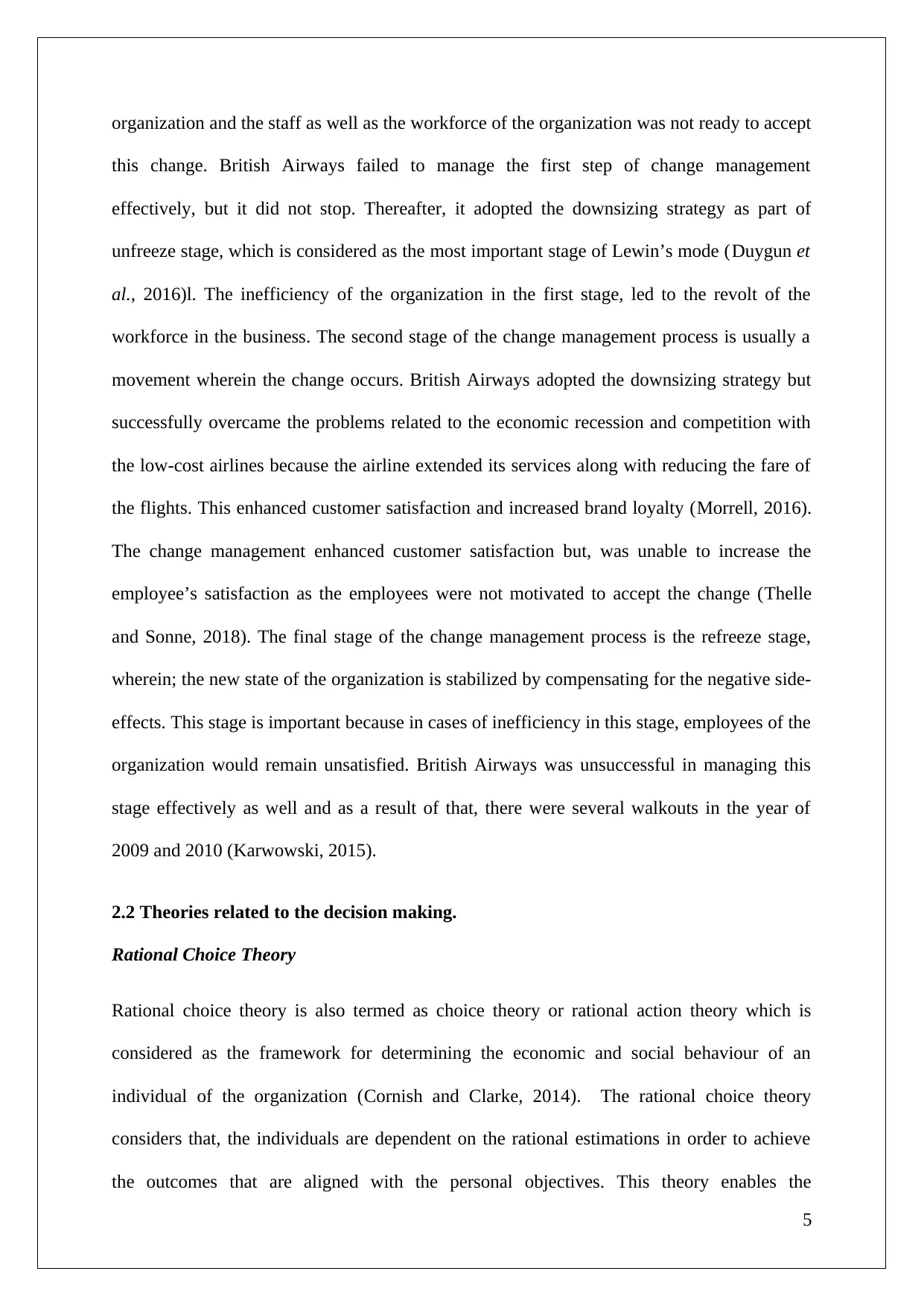
organization and the staff as well as the workforce of the organization was not ready to accept
this change. British Airways failed to manage the first step of change management
effectively, but it did not stop. Thereafter, it adopted the downsizing strategy as part of
unfreeze stage, which is considered as the most important stage of Lewin’s mode (Duygun et
al., 2016)l. The inefficiency of the organization in the first stage, led to the revolt of the
workforce in the business. The second stage of the change management process is usually a
movement wherein the change occurs. British Airways adopted the downsizing strategy but
successfully overcame the problems related to the economic recession and competition with
the low-cost airlines because the airline extended its services along with reducing the fare of
the flights. This enhanced customer satisfaction and increased brand loyalty (Morrell, 2016).
The change management enhanced customer satisfaction but, was unable to increase the
employee’s satisfaction as the employees were not motivated to accept the change (Thelle
and Sonne, 2018). The final stage of the change management process is the refreeze stage,
wherein; the new state of the organization is stabilized by compensating for the negative side-
effects. This stage is important because in cases of inefficiency in this stage, employees of the
organization would remain unsatisfied. British Airways was unsuccessful in managing this
stage effectively as well and as a result of that, there were several walkouts in the year of
2009 and 2010 (Karwowski, 2015).
2.2 Theories related to the decision making.
Rational Choice Theory
Rational choice theory is also termed as choice theory or rational action theory which is
considered as the framework for determining the economic and social behaviour of an
individual of the organization (Cornish and Clarke, 2014). The rational choice theory
considers that, the individuals are dependent on the rational estimations in order to achieve
the outcomes that are aligned with the personal objectives. This theory enables the
5
this change. British Airways failed to manage the first step of change management
effectively, but it did not stop. Thereafter, it adopted the downsizing strategy as part of
unfreeze stage, which is considered as the most important stage of Lewin’s mode (Duygun et
al., 2016)l. The inefficiency of the organization in the first stage, led to the revolt of the
workforce in the business. The second stage of the change management process is usually a
movement wherein the change occurs. British Airways adopted the downsizing strategy but
successfully overcame the problems related to the economic recession and competition with
the low-cost airlines because the airline extended its services along with reducing the fare of
the flights. This enhanced customer satisfaction and increased brand loyalty (Morrell, 2016).
The change management enhanced customer satisfaction but, was unable to increase the
employee’s satisfaction as the employees were not motivated to accept the change (Thelle
and Sonne, 2018). The final stage of the change management process is the refreeze stage,
wherein; the new state of the organization is stabilized by compensating for the negative side-
effects. This stage is important because in cases of inefficiency in this stage, employees of the
organization would remain unsatisfied. British Airways was unsuccessful in managing this
stage effectively as well and as a result of that, there were several walkouts in the year of
2009 and 2010 (Karwowski, 2015).
2.2 Theories related to the decision making.
Rational Choice Theory
Rational choice theory is also termed as choice theory or rational action theory which is
considered as the framework for determining the economic and social behaviour of an
individual of the organization (Cornish and Clarke, 2014). The rational choice theory
considers that, the individuals are dependent on the rational estimations in order to achieve
the outcomes that are aligned with the personal objectives. This theory enables the
5
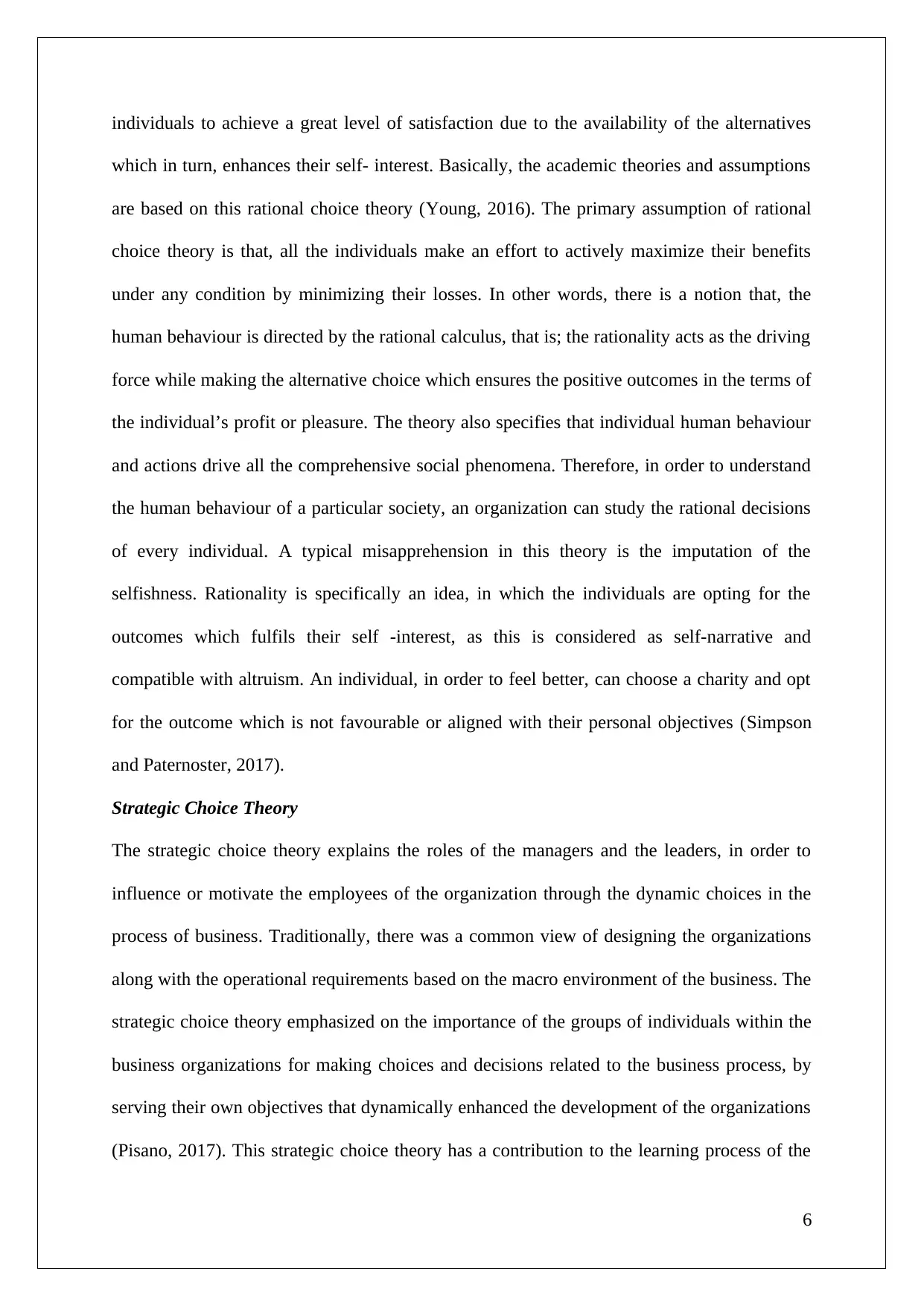
individuals to achieve a great level of satisfaction due to the availability of the alternatives
which in turn, enhances their self- interest. Basically, the academic theories and assumptions
are based on this rational choice theory (Young, 2016). The primary assumption of rational
choice theory is that, all the individuals make an effort to actively maximize their benefits
under any condition by minimizing their losses. In other words, there is a notion that, the
human behaviour is directed by the rational calculus, that is; the rationality acts as the driving
force while making the alternative choice which ensures the positive outcomes in the terms of
the individual’s profit or pleasure. The theory also specifies that individual human behaviour
and actions drive all the comprehensive social phenomena. Therefore, in order to understand
the human behaviour of a particular society, an organization can study the rational decisions
of every individual. A typical misapprehension in this theory is the imputation of the
selfishness. Rationality is specifically an idea, in which the individuals are opting for the
outcomes which fulfils their self -interest, as this is considered as self-narrative and
compatible with altruism. An individual, in order to feel better, can choose a charity and opt
for the outcome which is not favourable or aligned with their personal objectives (Simpson
and Paternoster, 2017).
Strategic Choice Theory
The strategic choice theory explains the roles of the managers and the leaders, in order to
influence or motivate the employees of the organization through the dynamic choices in the
process of business. Traditionally, there was a common view of designing the organizations
along with the operational requirements based on the macro environment of the business. The
strategic choice theory emphasized on the importance of the groups of individuals within the
business organizations for making choices and decisions related to the business process, by
serving their own objectives that dynamically enhanced the development of the organizations
(Pisano, 2017). This strategic choice theory has a contribution to the learning process of the
6
which in turn, enhances their self- interest. Basically, the academic theories and assumptions
are based on this rational choice theory (Young, 2016). The primary assumption of rational
choice theory is that, all the individuals make an effort to actively maximize their benefits
under any condition by minimizing their losses. In other words, there is a notion that, the
human behaviour is directed by the rational calculus, that is; the rationality acts as the driving
force while making the alternative choice which ensures the positive outcomes in the terms of
the individual’s profit or pleasure. The theory also specifies that individual human behaviour
and actions drive all the comprehensive social phenomena. Therefore, in order to understand
the human behaviour of a particular society, an organization can study the rational decisions
of every individual. A typical misapprehension in this theory is the imputation of the
selfishness. Rationality is specifically an idea, in which the individuals are opting for the
outcomes which fulfils their self -interest, as this is considered as self-narrative and
compatible with altruism. An individual, in order to feel better, can choose a charity and opt
for the outcome which is not favourable or aligned with their personal objectives (Simpson
and Paternoster, 2017).
Strategic Choice Theory
The strategic choice theory explains the roles of the managers and the leaders, in order to
influence or motivate the employees of the organization through the dynamic choices in the
process of business. Traditionally, there was a common view of designing the organizations
along with the operational requirements based on the macro environment of the business. The
strategic choice theory emphasized on the importance of the groups of individuals within the
business organizations for making choices and decisions related to the business process, by
serving their own objectives that dynamically enhanced the development of the organizations
(Pisano, 2017). This strategic choice theory has a contribution to the learning process of the
6
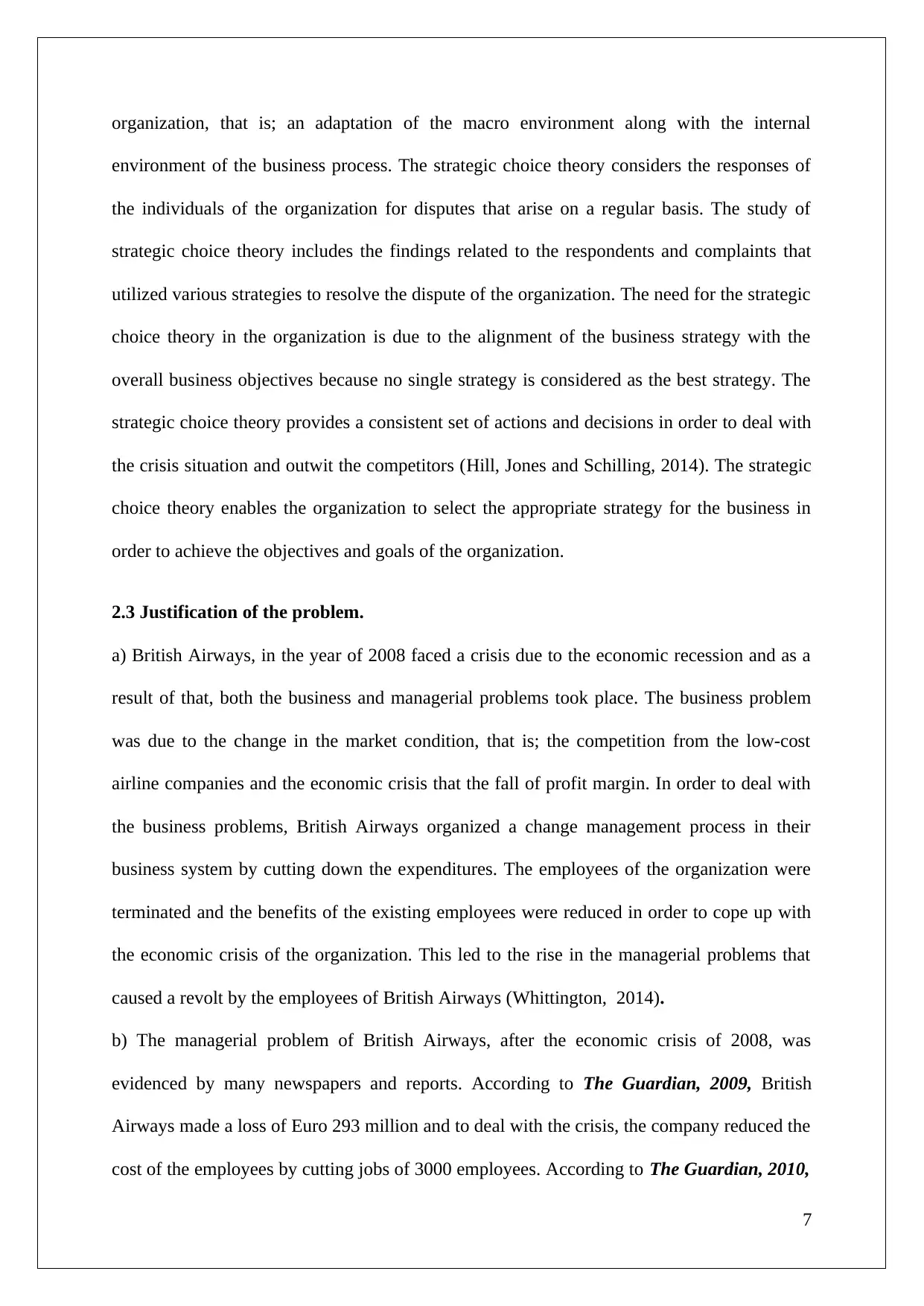
organization, that is; an adaptation of the macro environment along with the internal
environment of the business process. The strategic choice theory considers the responses of
the individuals of the organization for disputes that arise on a regular basis. The study of
strategic choice theory includes the findings related to the respondents and complaints that
utilized various strategies to resolve the dispute of the organization. The need for the strategic
choice theory in the organization is due to the alignment of the business strategy with the
overall business objectives because no single strategy is considered as the best strategy. The
strategic choice theory provides a consistent set of actions and decisions in order to deal with
the crisis situation and outwit the competitors (Hill, Jones and Schilling, 2014). The strategic
choice theory enables the organization to select the appropriate strategy for the business in
order to achieve the objectives and goals of the organization.
2.3 Justification of the problem.
a) British Airways, in the year of 2008 faced a crisis due to the economic recession and as a
result of that, both the business and managerial problems took place. The business problem
was due to the change in the market condition, that is; the competition from the low-cost
airline companies and the economic crisis that the fall of profit margin. In order to deal with
the business problems, British Airways organized a change management process in their
business system by cutting down the expenditures. The employees of the organization were
terminated and the benefits of the existing employees were reduced in order to cope up with
the economic crisis of the organization. This led to the rise in the managerial problems that
caused a revolt by the employees of British Airways (Whittington, 2014).
b) The managerial problem of British Airways, after the economic crisis of 2008, was
evidenced by many newspapers and reports. According to The Guardian, 2009, British
Airways made a loss of Euro 293 million and to deal with the crisis, the company reduced the
cost of the employees by cutting jobs of 3000 employees. According to The Guardian, 2010,
7
environment of the business process. The strategic choice theory considers the responses of
the individuals of the organization for disputes that arise on a regular basis. The study of
strategic choice theory includes the findings related to the respondents and complaints that
utilized various strategies to resolve the dispute of the organization. The need for the strategic
choice theory in the organization is due to the alignment of the business strategy with the
overall business objectives because no single strategy is considered as the best strategy. The
strategic choice theory provides a consistent set of actions and decisions in order to deal with
the crisis situation and outwit the competitors (Hill, Jones and Schilling, 2014). The strategic
choice theory enables the organization to select the appropriate strategy for the business in
order to achieve the objectives and goals of the organization.
2.3 Justification of the problem.
a) British Airways, in the year of 2008 faced a crisis due to the economic recession and as a
result of that, both the business and managerial problems took place. The business problem
was due to the change in the market condition, that is; the competition from the low-cost
airline companies and the economic crisis that the fall of profit margin. In order to deal with
the business problems, British Airways organized a change management process in their
business system by cutting down the expenditures. The employees of the organization were
terminated and the benefits of the existing employees were reduced in order to cope up with
the economic crisis of the organization. This led to the rise in the managerial problems that
caused a revolt by the employees of British Airways (Whittington, 2014).
b) The managerial problem of British Airways, after the economic crisis of 2008, was
evidenced by many newspapers and reports. According to The Guardian, 2009, British
Airways made a loss of Euro 293 million and to deal with the crisis, the company reduced the
cost of the employees by cutting jobs of 3000 employees. According to The Guardian, 2010,
7
Paraphrase This Document
Need a fresh take? Get an instant paraphrase of this document with our AI Paraphraser
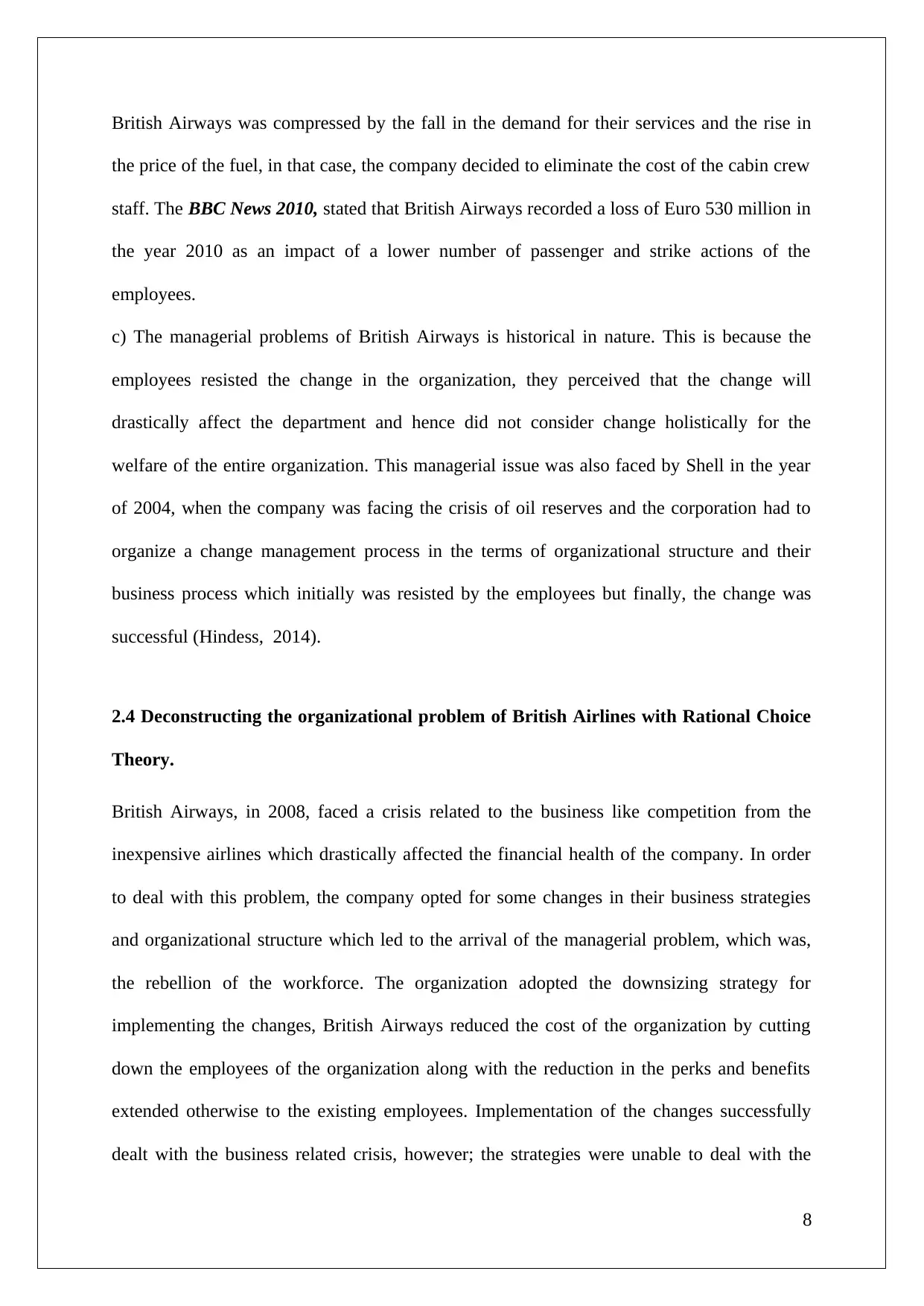
British Airways was compressed by the fall in the demand for their services and the rise in
the price of the fuel, in that case, the company decided to eliminate the cost of the cabin crew
staff. The BBC News 2010, stated that British Airways recorded a loss of Euro 530 million in
the year 2010 as an impact of a lower number of passenger and strike actions of the
employees.
c) The managerial problems of British Airways is historical in nature. This is because the
employees resisted the change in the organization, they perceived that the change will
drastically affect the department and hence did not consider change holistically for the
welfare of the entire organization. This managerial issue was also faced by Shell in the year
of 2004, when the company was facing the crisis of oil reserves and the corporation had to
organize a change management process in the terms of organizational structure and their
business process which initially was resisted by the employees but finally, the change was
successful (Hindess, 2014).
2.4 Deconstructing the organizational problem of British Airlines with Rational Choice
Theory.
British Airways, in 2008, faced a crisis related to the business like competition from the
inexpensive airlines which drastically affected the financial health of the company. In order
to deal with this problem, the company opted for some changes in their business strategies
and organizational structure which led to the arrival of the managerial problem, which was,
the rebellion of the workforce. The organization adopted the downsizing strategy for
implementing the changes, British Airways reduced the cost of the organization by cutting
down the employees of the organization along with the reduction in the perks and benefits
extended otherwise to the existing employees. Implementation of the changes successfully
dealt with the business related crisis, however; the strategies were unable to deal with the
8
the price of the fuel, in that case, the company decided to eliminate the cost of the cabin crew
staff. The BBC News 2010, stated that British Airways recorded a loss of Euro 530 million in
the year 2010 as an impact of a lower number of passenger and strike actions of the
employees.
c) The managerial problems of British Airways is historical in nature. This is because the
employees resisted the change in the organization, they perceived that the change will
drastically affect the department and hence did not consider change holistically for the
welfare of the entire organization. This managerial issue was also faced by Shell in the year
of 2004, when the company was facing the crisis of oil reserves and the corporation had to
organize a change management process in the terms of organizational structure and their
business process which initially was resisted by the employees but finally, the change was
successful (Hindess, 2014).
2.4 Deconstructing the organizational problem of British Airlines with Rational Choice
Theory.
British Airways, in 2008, faced a crisis related to the business like competition from the
inexpensive airlines which drastically affected the financial health of the company. In order
to deal with this problem, the company opted for some changes in their business strategies
and organizational structure which led to the arrival of the managerial problem, which was,
the rebellion of the workforce. The organization adopted the downsizing strategy for
implementing the changes, British Airways reduced the cost of the organization by cutting
down the employees of the organization along with the reduction in the perks and benefits
extended otherwise to the existing employees. Implementation of the changes successfully
dealt with the business related crisis, however; the strategies were unable to deal with the
8
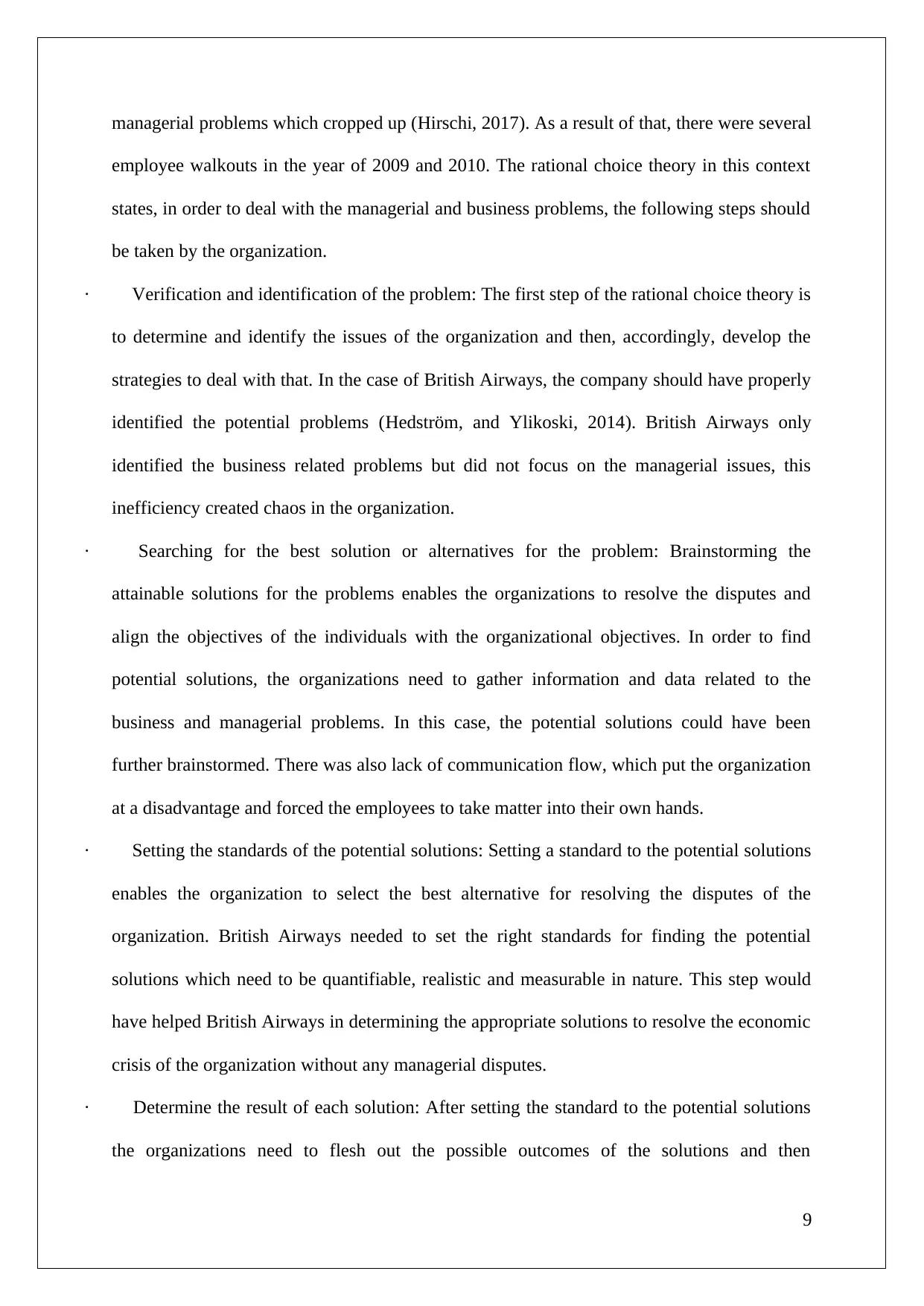
managerial problems which cropped up (Hirschi, 2017). As a result of that, there were several
employee walkouts in the year of 2009 and 2010. The rational choice theory in this context
states, in order to deal with the managerial and business problems, the following steps should
be taken by the organization.
· Verification and identification of the problem: The first step of the rational choice theory is
to determine and identify the issues of the organization and then, accordingly, develop the
strategies to deal with that. In the case of British Airways, the company should have properly
identified the potential problems (Hedström, and Ylikoski, 2014). British Airways only
identified the business related problems but did not focus on the managerial issues, this
inefficiency created chaos in the organization.
· Searching for the best solution or alternatives for the problem: Brainstorming the
attainable solutions for the problems enables the organizations to resolve the disputes and
align the objectives of the individuals with the organizational objectives. In order to find
potential solutions, the organizations need to gather information and data related to the
business and managerial problems. In this case, the potential solutions could have been
further brainstormed. There was also lack of communication flow, which put the organization
at a disadvantage and forced the employees to take matter into their own hands.
· Setting the standards of the potential solutions: Setting a standard to the potential solutions
enables the organization to select the best alternative for resolving the disputes of the
organization. British Airways needed to set the right standards for finding the potential
solutions which need to be quantifiable, realistic and measurable in nature. This step would
have helped British Airways in determining the appropriate solutions to resolve the economic
crisis of the organization without any managerial disputes.
· Determine the result of each solution: After setting the standard to the potential solutions
the organizations need to flesh out the possible outcomes of the solutions and then
9
employee walkouts in the year of 2009 and 2010. The rational choice theory in this context
states, in order to deal with the managerial and business problems, the following steps should
be taken by the organization.
· Verification and identification of the problem: The first step of the rational choice theory is
to determine and identify the issues of the organization and then, accordingly, develop the
strategies to deal with that. In the case of British Airways, the company should have properly
identified the potential problems (Hedström, and Ylikoski, 2014). British Airways only
identified the business related problems but did not focus on the managerial issues, this
inefficiency created chaos in the organization.
· Searching for the best solution or alternatives for the problem: Brainstorming the
attainable solutions for the problems enables the organizations to resolve the disputes and
align the objectives of the individuals with the organizational objectives. In order to find
potential solutions, the organizations need to gather information and data related to the
business and managerial problems. In this case, the potential solutions could have been
further brainstormed. There was also lack of communication flow, which put the organization
at a disadvantage and forced the employees to take matter into their own hands.
· Setting the standards of the potential solutions: Setting a standard to the potential solutions
enables the organization to select the best alternative for resolving the disputes of the
organization. British Airways needed to set the right standards for finding the potential
solutions which need to be quantifiable, realistic and measurable in nature. This step would
have helped British Airways in determining the appropriate solutions to resolve the economic
crisis of the organization without any managerial disputes.
· Determine the result of each solution: After setting the standard to the potential solutions
the organizations need to flesh out the possible outcomes of the solutions and then
9
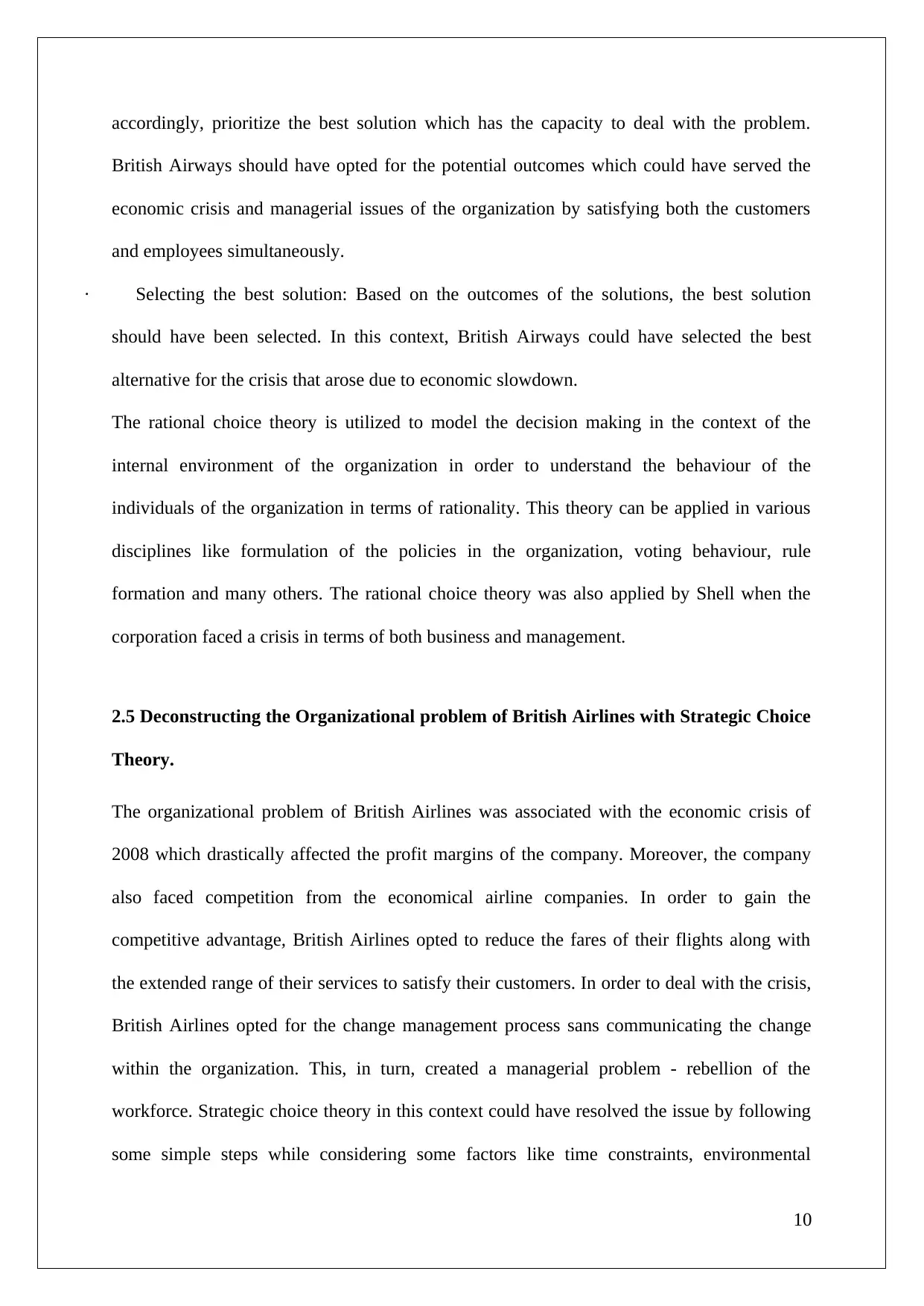
accordingly, prioritize the best solution which has the capacity to deal with the problem.
British Airways should have opted for the potential outcomes which could have served the
economic crisis and managerial issues of the organization by satisfying both the customers
and employees simultaneously.
· Selecting the best solution: Based on the outcomes of the solutions, the best solution
should have been selected. In this context, British Airways could have selected the best
alternative for the crisis that arose due to economic slowdown.
The rational choice theory is utilized to model the decision making in the context of the
internal environment of the organization in order to understand the behaviour of the
individuals of the organization in terms of rationality. This theory can be applied in various
disciplines like formulation of the policies in the organization, voting behaviour, rule
formation and many others. The rational choice theory was also applied by Shell when the
corporation faced a crisis in terms of both business and management.
2.5 Deconstructing the Organizational problem of British Airlines with Strategic Choice
Theory.
The organizational problem of British Airlines was associated with the economic crisis of
2008 which drastically affected the profit margins of the company. Moreover, the company
also faced competition from the economical airline companies. In order to gain the
competitive advantage, British Airlines opted to reduce the fares of their flights along with
the extended range of their services to satisfy their customers. In order to deal with the crisis,
British Airlines opted for the change management process sans communicating the change
within the organization. This, in turn, created a managerial problem - rebellion of the
workforce. Strategic choice theory in this context could have resolved the issue by following
some simple steps while considering some factors like time constraints, environmental
10
British Airways should have opted for the potential outcomes which could have served the
economic crisis and managerial issues of the organization by satisfying both the customers
and employees simultaneously.
· Selecting the best solution: Based on the outcomes of the solutions, the best solution
should have been selected. In this context, British Airways could have selected the best
alternative for the crisis that arose due to economic slowdown.
The rational choice theory is utilized to model the decision making in the context of the
internal environment of the organization in order to understand the behaviour of the
individuals of the organization in terms of rationality. This theory can be applied in various
disciplines like formulation of the policies in the organization, voting behaviour, rule
formation and many others. The rational choice theory was also applied by Shell when the
corporation faced a crisis in terms of both business and management.
2.5 Deconstructing the Organizational problem of British Airlines with Strategic Choice
Theory.
The organizational problem of British Airlines was associated with the economic crisis of
2008 which drastically affected the profit margins of the company. Moreover, the company
also faced competition from the economical airline companies. In order to gain the
competitive advantage, British Airlines opted to reduce the fares of their flights along with
the extended range of their services to satisfy their customers. In order to deal with the crisis,
British Airlines opted for the change management process sans communicating the change
within the organization. This, in turn, created a managerial problem - rebellion of the
workforce. Strategic choice theory in this context could have resolved the issue by following
some simple steps while considering some factors like time constraints, environmental
10
Secure Best Marks with AI Grader
Need help grading? Try our AI Grader for instant feedback on your assignments.
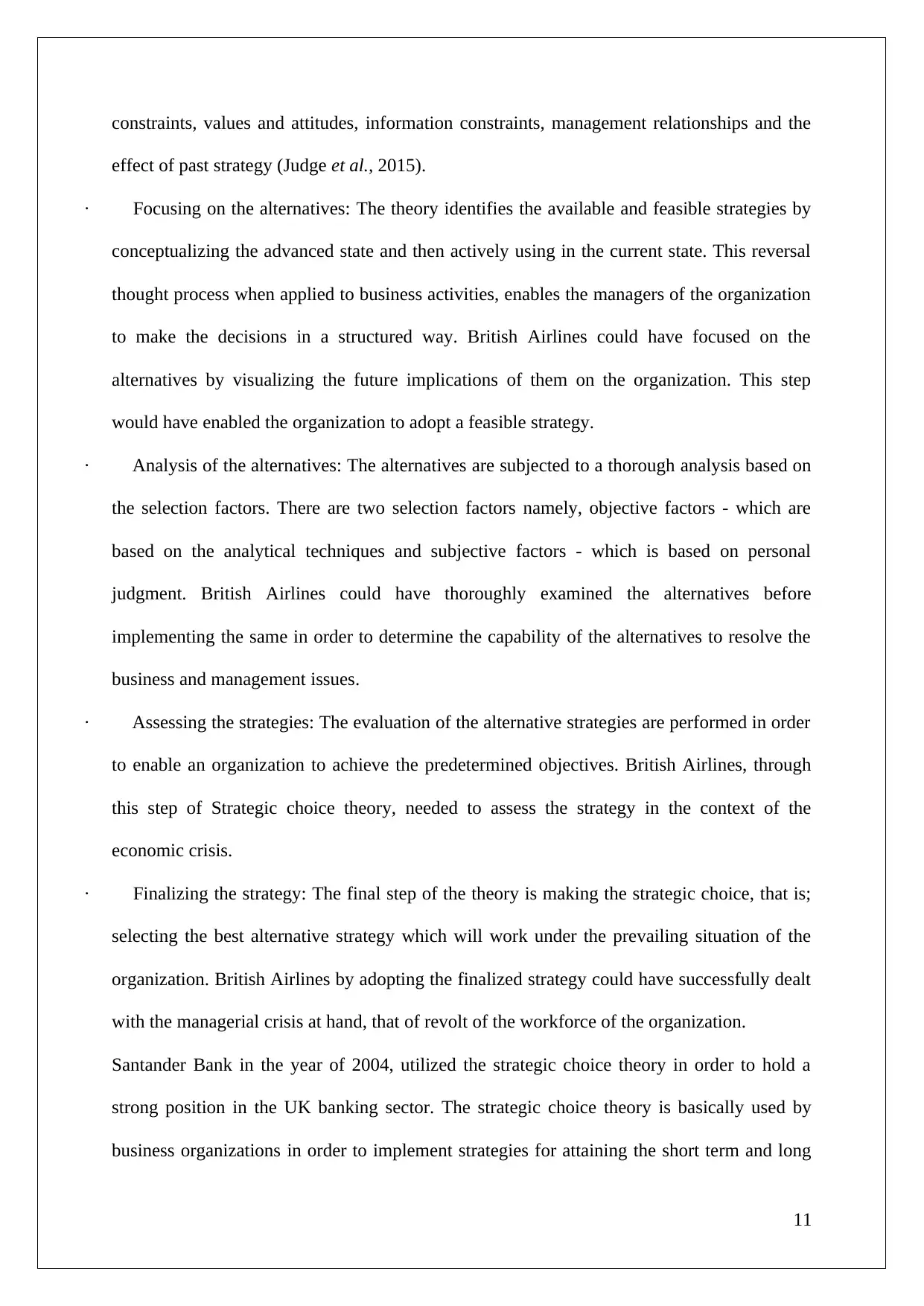
constraints, values and attitudes, information constraints, management relationships and the
effect of past strategy (Judge et al., 2015).
· Focusing on the alternatives: The theory identifies the available and feasible strategies by
conceptualizing the advanced state and then actively using in the current state. This reversal
thought process when applied to business activities, enables the managers of the organization
to make the decisions in a structured way. British Airlines could have focused on the
alternatives by visualizing the future implications of them on the organization. This step
would have enabled the organization to adopt a feasible strategy.
· Analysis of the alternatives: The alternatives are subjected to a thorough analysis based on
the selection factors. There are two selection factors namely, objective factors - which are
based on the analytical techniques and subjective factors - which is based on personal
judgment. British Airlines could have thoroughly examined the alternatives before
implementing the same in order to determine the capability of the alternatives to resolve the
business and management issues.
· Assessing the strategies: The evaluation of the alternative strategies are performed in order
to enable an organization to achieve the predetermined objectives. British Airlines, through
this step of Strategic choice theory, needed to assess the strategy in the context of the
economic crisis.
· Finalizing the strategy: The final step of the theory is making the strategic choice, that is;
selecting the best alternative strategy which will work under the prevailing situation of the
organization. British Airlines by adopting the finalized strategy could have successfully dealt
with the managerial crisis at hand, that of revolt of the workforce of the organization.
Santander Bank in the year of 2004, utilized the strategic choice theory in order to hold a
strong position in the UK banking sector. The strategic choice theory is basically used by
business organizations in order to implement strategies for attaining the short term and long
11
effect of past strategy (Judge et al., 2015).
· Focusing on the alternatives: The theory identifies the available and feasible strategies by
conceptualizing the advanced state and then actively using in the current state. This reversal
thought process when applied to business activities, enables the managers of the organization
to make the decisions in a structured way. British Airlines could have focused on the
alternatives by visualizing the future implications of them on the organization. This step
would have enabled the organization to adopt a feasible strategy.
· Analysis of the alternatives: The alternatives are subjected to a thorough analysis based on
the selection factors. There are two selection factors namely, objective factors - which are
based on the analytical techniques and subjective factors - which is based on personal
judgment. British Airlines could have thoroughly examined the alternatives before
implementing the same in order to determine the capability of the alternatives to resolve the
business and management issues.
· Assessing the strategies: The evaluation of the alternative strategies are performed in order
to enable an organization to achieve the predetermined objectives. British Airlines, through
this step of Strategic choice theory, needed to assess the strategy in the context of the
economic crisis.
· Finalizing the strategy: The final step of the theory is making the strategic choice, that is;
selecting the best alternative strategy which will work under the prevailing situation of the
organization. British Airlines by adopting the finalized strategy could have successfully dealt
with the managerial crisis at hand, that of revolt of the workforce of the organization.
Santander Bank in the year of 2004, utilized the strategic choice theory in order to hold a
strong position in the UK banking sector. The strategic choice theory is basically used by
business organizations in order to implement strategies for attaining the short term and long
11
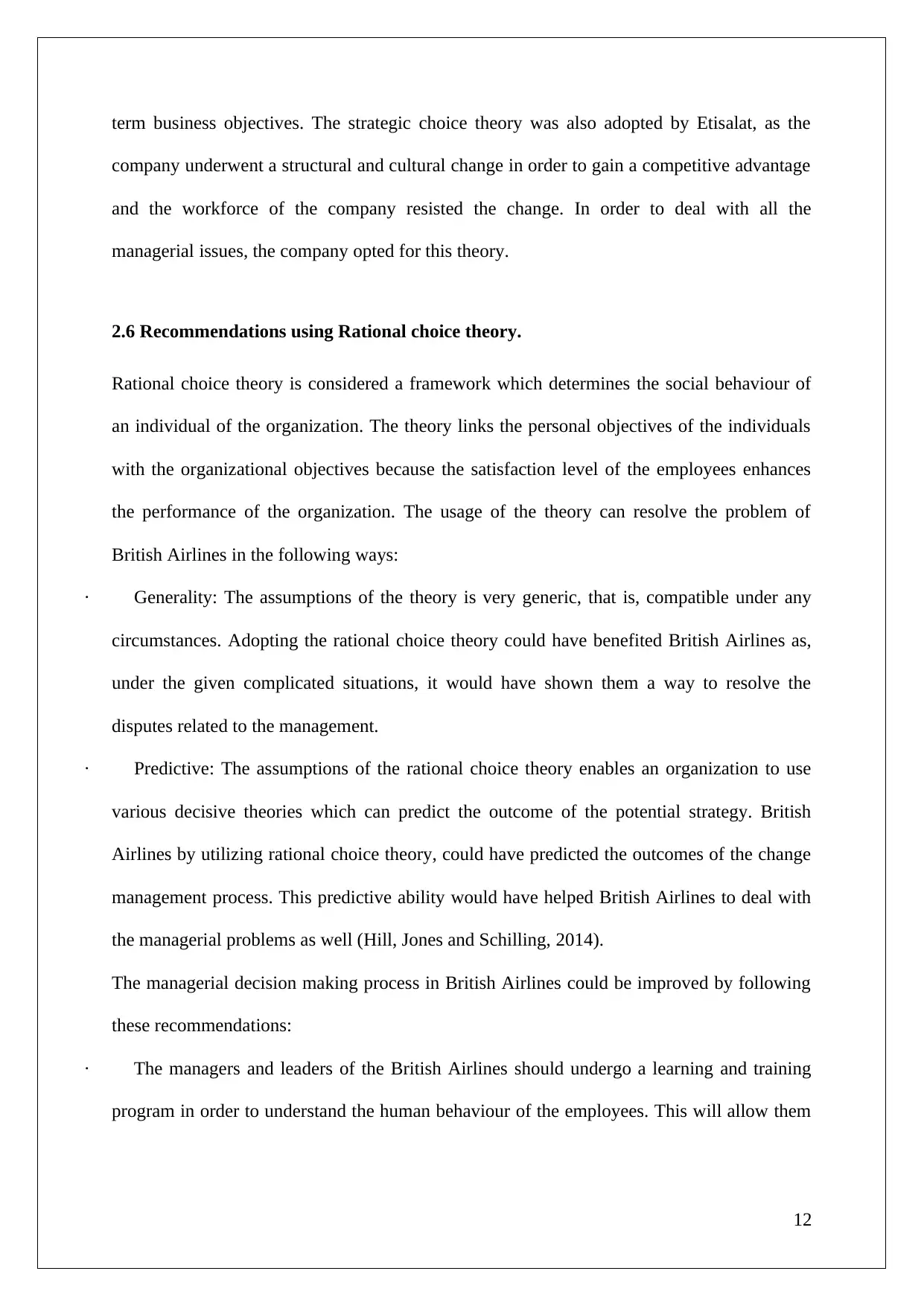
term business objectives. The strategic choice theory was also adopted by Etisalat, as the
company underwent a structural and cultural change in order to gain a competitive advantage
and the workforce of the company resisted the change. In order to deal with all the
managerial issues, the company opted for this theory.
2.6 Recommendations using Rational choice theory.
Rational choice theory is considered a framework which determines the social behaviour of
an individual of the organization. The theory links the personal objectives of the individuals
with the organizational objectives because the satisfaction level of the employees enhances
the performance of the organization. The usage of the theory can resolve the problem of
British Airlines in the following ways:
· Generality: The assumptions of the theory is very generic, that is, compatible under any
circumstances. Adopting the rational choice theory could have benefited British Airlines as,
under the given complicated situations, it would have shown them a way to resolve the
disputes related to the management.
· Predictive: The assumptions of the rational choice theory enables an organization to use
various decisive theories which can predict the outcome of the potential strategy. British
Airlines by utilizing rational choice theory, could have predicted the outcomes of the change
management process. This predictive ability would have helped British Airlines to deal with
the managerial problems as well (Hill, Jones and Schilling, 2014).
The managerial decision making process in British Airlines could be improved by following
these recommendations:
· The managers and leaders of the British Airlines should undergo a learning and training
program in order to understand the human behaviour of the employees. This will allow them
12
company underwent a structural and cultural change in order to gain a competitive advantage
and the workforce of the company resisted the change. In order to deal with all the
managerial issues, the company opted for this theory.
2.6 Recommendations using Rational choice theory.
Rational choice theory is considered a framework which determines the social behaviour of
an individual of the organization. The theory links the personal objectives of the individuals
with the organizational objectives because the satisfaction level of the employees enhances
the performance of the organization. The usage of the theory can resolve the problem of
British Airlines in the following ways:
· Generality: The assumptions of the theory is very generic, that is, compatible under any
circumstances. Adopting the rational choice theory could have benefited British Airlines as,
under the given complicated situations, it would have shown them a way to resolve the
disputes related to the management.
· Predictive: The assumptions of the rational choice theory enables an organization to use
various decisive theories which can predict the outcome of the potential strategy. British
Airlines by utilizing rational choice theory, could have predicted the outcomes of the change
management process. This predictive ability would have helped British Airlines to deal with
the managerial problems as well (Hill, Jones and Schilling, 2014).
The managerial decision making process in British Airlines could be improved by following
these recommendations:
· The managers and leaders of the British Airlines should undergo a learning and training
program in order to understand the human behaviour of the employees. This will allow them
12
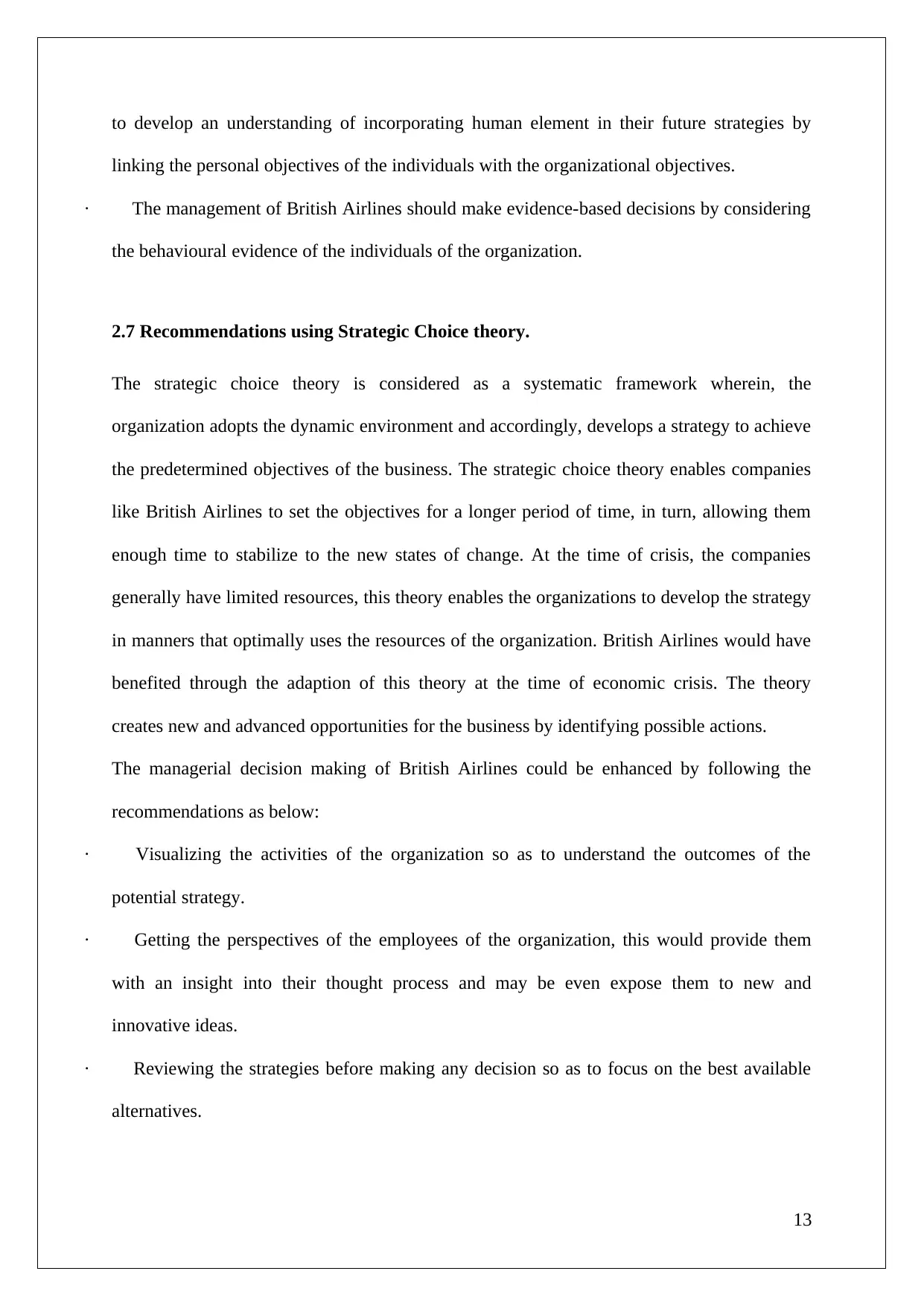
to develop an understanding of incorporating human element in their future strategies by
linking the personal objectives of the individuals with the organizational objectives.
· The management of British Airlines should make evidence-based decisions by considering
the behavioural evidence of the individuals of the organization.
2.7 Recommendations using Strategic Choice theory.
The strategic choice theory is considered as a systematic framework wherein, the
organization adopts the dynamic environment and accordingly, develops a strategy to achieve
the predetermined objectives of the business. The strategic choice theory enables companies
like British Airlines to set the objectives for a longer period of time, in turn, allowing them
enough time to stabilize to the new states of change. At the time of crisis, the companies
generally have limited resources, this theory enables the organizations to develop the strategy
in manners that optimally uses the resources of the organization. British Airlines would have
benefited through the adaption of this theory at the time of economic crisis. The theory
creates new and advanced opportunities for the business by identifying possible actions.
The managerial decision making of British Airlines could be enhanced by following the
recommendations as below:
· Visualizing the activities of the organization so as to understand the outcomes of the
potential strategy.
· Getting the perspectives of the employees of the organization, this would provide them
with an insight into their thought process and may be even expose them to new and
innovative ideas.
· Reviewing the strategies before making any decision so as to focus on the best available
alternatives.
13
linking the personal objectives of the individuals with the organizational objectives.
· The management of British Airlines should make evidence-based decisions by considering
the behavioural evidence of the individuals of the organization.
2.7 Recommendations using Strategic Choice theory.
The strategic choice theory is considered as a systematic framework wherein, the
organization adopts the dynamic environment and accordingly, develops a strategy to achieve
the predetermined objectives of the business. The strategic choice theory enables companies
like British Airlines to set the objectives for a longer period of time, in turn, allowing them
enough time to stabilize to the new states of change. At the time of crisis, the companies
generally have limited resources, this theory enables the organizations to develop the strategy
in manners that optimally uses the resources of the organization. British Airlines would have
benefited through the adaption of this theory at the time of economic crisis. The theory
creates new and advanced opportunities for the business by identifying possible actions.
The managerial decision making of British Airlines could be enhanced by following the
recommendations as below:
· Visualizing the activities of the organization so as to understand the outcomes of the
potential strategy.
· Getting the perspectives of the employees of the organization, this would provide them
with an insight into their thought process and may be even expose them to new and
innovative ideas.
· Reviewing the strategies before making any decision so as to focus on the best available
alternatives.
13
Paraphrase This Document
Need a fresh take? Get an instant paraphrase of this document with our AI Paraphraser
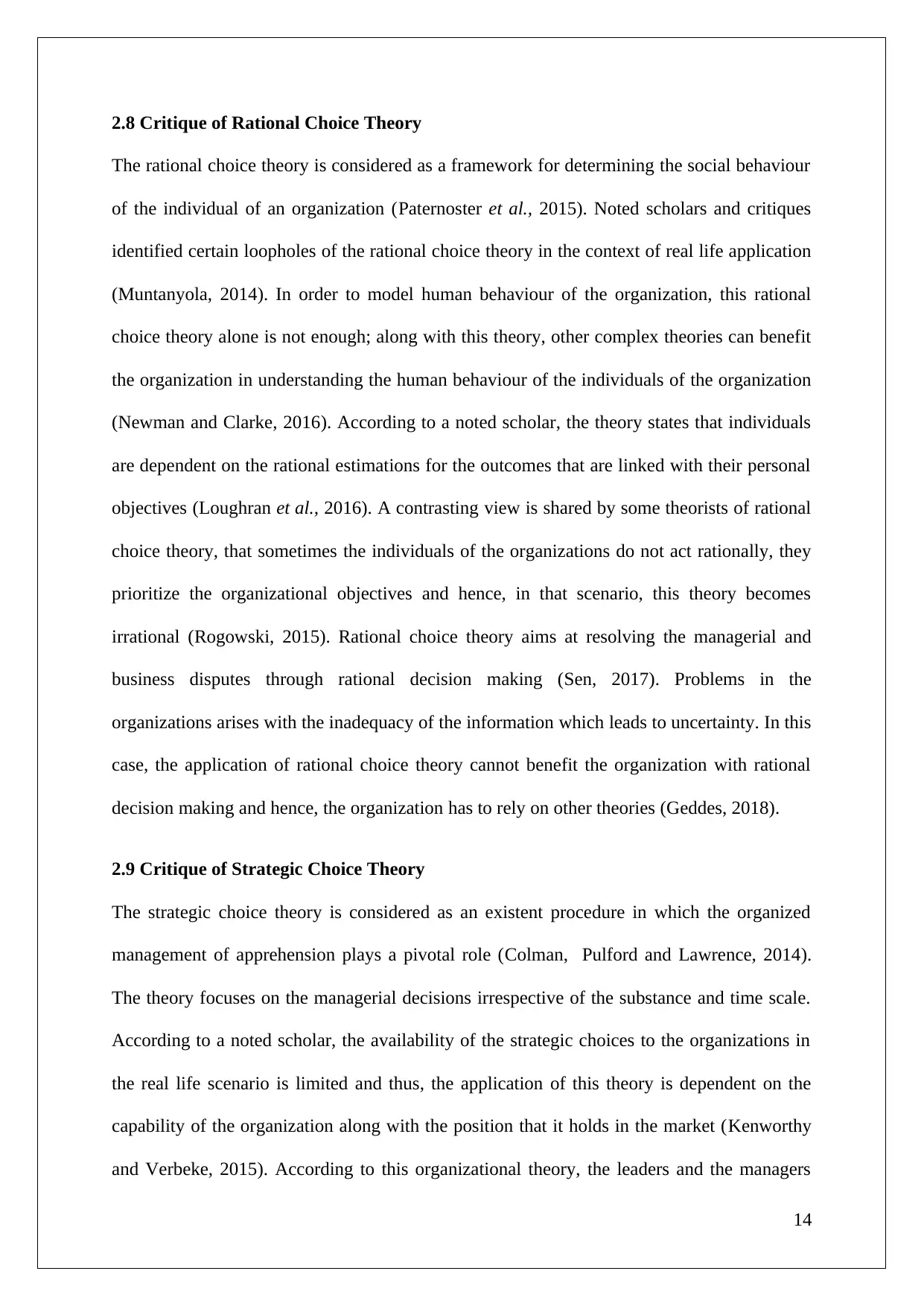
2.8 Critique of Rational Choice Theory
The rational choice theory is considered as a framework for determining the social behaviour
of the individual of an organization (Paternoster et al., 2015). Noted scholars and critiques
identified certain loopholes of the rational choice theory in the context of real life application
(Muntanyola, 2014). In order to model human behaviour of the organization, this rational
choice theory alone is not enough; along with this theory, other complex theories can benefit
the organization in understanding the human behaviour of the individuals of the organization
(Newman and Clarke, 2016). According to a noted scholar, the theory states that individuals
are dependent on the rational estimations for the outcomes that are linked with their personal
objectives (Loughran et al., 2016). A contrasting view is shared by some theorists of rational
choice theory, that sometimes the individuals of the organizations do not act rationally, they
prioritize the organizational objectives and hence, in that scenario, this theory becomes
irrational (Rogowski, 2015). Rational choice theory aims at resolving the managerial and
business disputes through rational decision making (Sen, 2017). Problems in the
organizations arises with the inadequacy of the information which leads to uncertainty. In this
case, the application of rational choice theory cannot benefit the organization with rational
decision making and hence, the organization has to rely on other theories (Geddes, 2018).
2.9 Critique of Strategic Choice Theory
The strategic choice theory is considered as an existent procedure in which the organized
management of apprehension plays a pivotal role (Colman, Pulford and Lawrence, 2014).
The theory focuses on the managerial decisions irrespective of the substance and time scale.
According to a noted scholar, the availability of the strategic choices to the organizations in
the real life scenario is limited and thus, the application of this theory is dependent on the
capability of the organization along with the position that it holds in the market (Kenworthy
and Verbeke, 2015). According to this organizational theory, the leaders and the managers
14
The rational choice theory is considered as a framework for determining the social behaviour
of the individual of an organization (Paternoster et al., 2015). Noted scholars and critiques
identified certain loopholes of the rational choice theory in the context of real life application
(Muntanyola, 2014). In order to model human behaviour of the organization, this rational
choice theory alone is not enough; along with this theory, other complex theories can benefit
the organization in understanding the human behaviour of the individuals of the organization
(Newman and Clarke, 2016). According to a noted scholar, the theory states that individuals
are dependent on the rational estimations for the outcomes that are linked with their personal
objectives (Loughran et al., 2016). A contrasting view is shared by some theorists of rational
choice theory, that sometimes the individuals of the organizations do not act rationally, they
prioritize the organizational objectives and hence, in that scenario, this theory becomes
irrational (Rogowski, 2015). Rational choice theory aims at resolving the managerial and
business disputes through rational decision making (Sen, 2017). Problems in the
organizations arises with the inadequacy of the information which leads to uncertainty. In this
case, the application of rational choice theory cannot benefit the organization with rational
decision making and hence, the organization has to rely on other theories (Geddes, 2018).
2.9 Critique of Strategic Choice Theory
The strategic choice theory is considered as an existent procedure in which the organized
management of apprehension plays a pivotal role (Colman, Pulford and Lawrence, 2014).
The theory focuses on the managerial decisions irrespective of the substance and time scale.
According to a noted scholar, the availability of the strategic choices to the organizations in
the real life scenario is limited and thus, the application of this theory is dependent on the
capability of the organization along with the position that it holds in the market (Kenworthy
and Verbeke, 2015). According to this organizational theory, the leaders and the managers
14
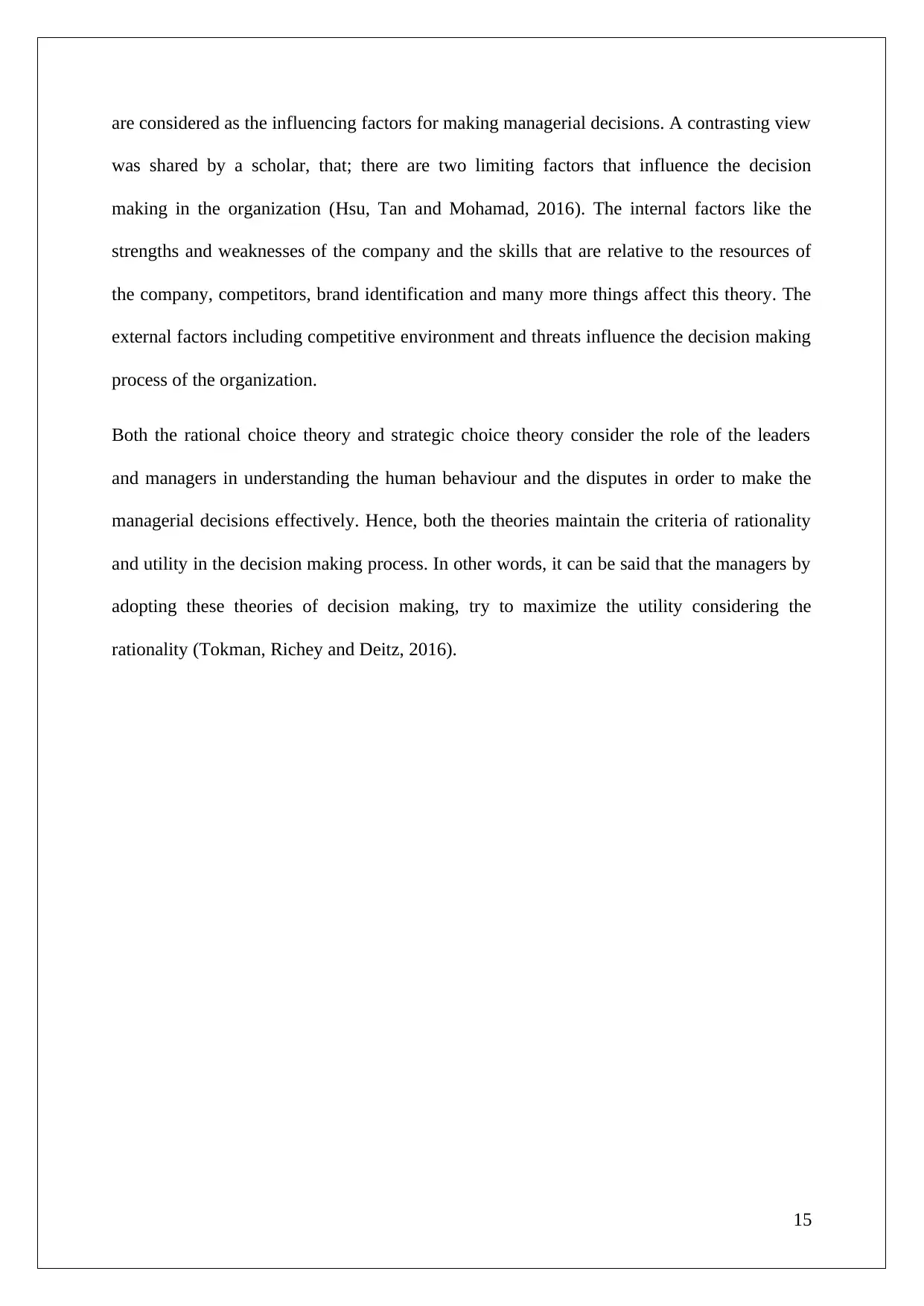
are considered as the influencing factors for making managerial decisions. A contrasting view
was shared by a scholar, that; there are two limiting factors that influence the decision
making in the organization (Hsu, Tan and Mohamad, 2016). The internal factors like the
strengths and weaknesses of the company and the skills that are relative to the resources of
the company, competitors, brand identification and many more things affect this theory. The
external factors including competitive environment and threats influence the decision making
process of the organization.
Both the rational choice theory and strategic choice theory consider the role of the leaders
and managers in understanding the human behaviour and the disputes in order to make the
managerial decisions effectively. Hence, both the theories maintain the criteria of rationality
and utility in the decision making process. In other words, it can be said that the managers by
adopting these theories of decision making, try to maximize the utility considering the
rationality (Tokman, Richey and Deitz, 2016).
15
was shared by a scholar, that; there are two limiting factors that influence the decision
making in the organization (Hsu, Tan and Mohamad, 2016). The internal factors like the
strengths and weaknesses of the company and the skills that are relative to the resources of
the company, competitors, brand identification and many more things affect this theory. The
external factors including competitive environment and threats influence the decision making
process of the organization.
Both the rational choice theory and strategic choice theory consider the role of the leaders
and managers in understanding the human behaviour and the disputes in order to make the
managerial decisions effectively. Hence, both the theories maintain the criteria of rationality
and utility in the decision making process. In other words, it can be said that the managers by
adopting these theories of decision making, try to maximize the utility considering the
rationality (Tokman, Richey and Deitz, 2016).
15
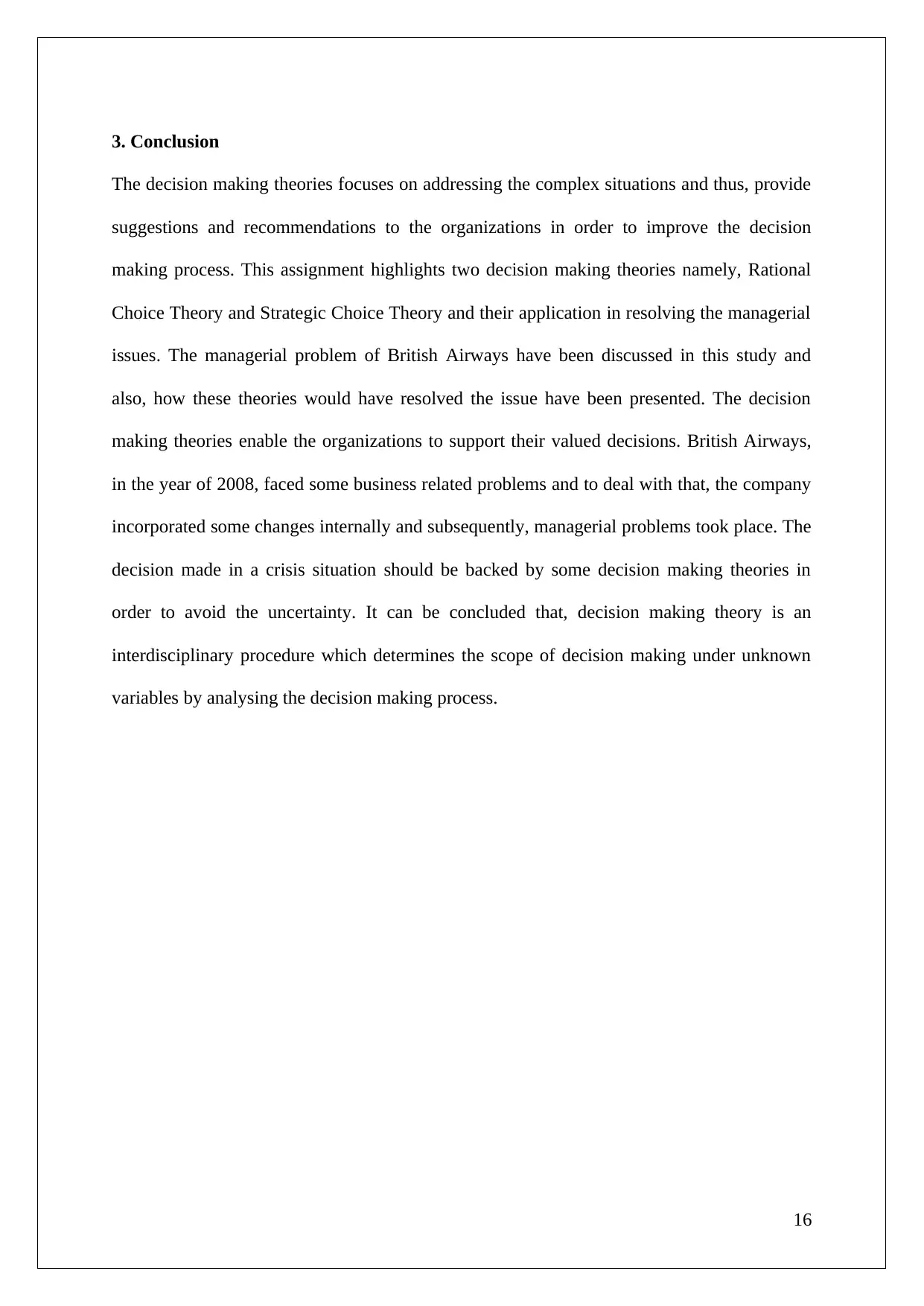
3. Conclusion
The decision making theories focuses on addressing the complex situations and thus, provide
suggestions and recommendations to the organizations in order to improve the decision
making process. This assignment highlights two decision making theories namely, Rational
Choice Theory and Strategic Choice Theory and their application in resolving the managerial
issues. The managerial problem of British Airways have been discussed in this study and
also, how these theories would have resolved the issue have been presented. The decision
making theories enable the organizations to support their valued decisions. British Airways,
in the year of 2008, faced some business related problems and to deal with that, the company
incorporated some changes internally and subsequently, managerial problems took place. The
decision made in a crisis situation should be backed by some decision making theories in
order to avoid the uncertainty. It can be concluded that, decision making theory is an
interdisciplinary procedure which determines the scope of decision making under unknown
variables by analysing the decision making process.
16
The decision making theories focuses on addressing the complex situations and thus, provide
suggestions and recommendations to the organizations in order to improve the decision
making process. This assignment highlights two decision making theories namely, Rational
Choice Theory and Strategic Choice Theory and their application in resolving the managerial
issues. The managerial problem of British Airways have been discussed in this study and
also, how these theories would have resolved the issue have been presented. The decision
making theories enable the organizations to support their valued decisions. British Airways,
in the year of 2008, faced some business related problems and to deal with that, the company
incorporated some changes internally and subsequently, managerial problems took place. The
decision made in a crisis situation should be backed by some decision making theories in
order to avoid the uncertainty. It can be concluded that, decision making theory is an
interdisciplinary procedure which determines the scope of decision making under unknown
variables by analysing the decision making process.
16
Secure Best Marks with AI Grader
Need help grading? Try our AI Grader for instant feedback on your assignments.
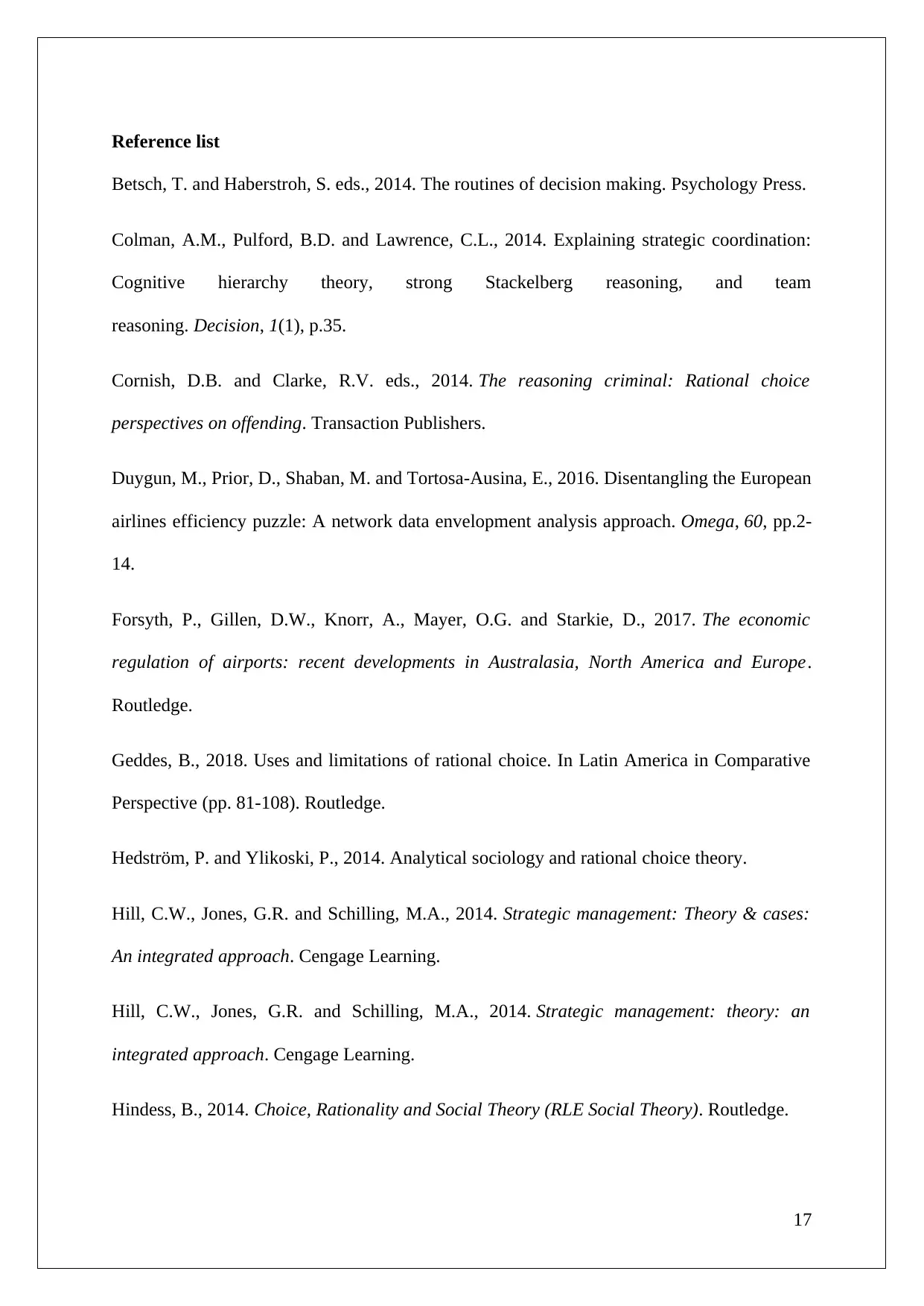
Reference list
Betsch, T. and Haberstroh, S. eds., 2014. The routines of decision making. Psychology Press.
Colman, A.M., Pulford, B.D. and Lawrence, C.L., 2014. Explaining strategic coordination:
Cognitive hierarchy theory, strong Stackelberg reasoning, and team
reasoning. Decision, 1(1), p.35.
Cornish, D.B. and Clarke, R.V. eds., 2014. The reasoning criminal: Rational choice
perspectives on offending. Transaction Publishers.
Duygun, M., Prior, D., Shaban, M. and Tortosa-Ausina, E., 2016. Disentangling the European
airlines efficiency puzzle: A network data envelopment analysis approach. Omega, 60, pp.2-
14.
Forsyth, P., Gillen, D.W., Knorr, A., Mayer, O.G. and Starkie, D., 2017. The economic
regulation of airports: recent developments in Australasia, North America and Europe.
Routledge.
Geddes, B., 2018. Uses and limitations of rational choice. In Latin America in Comparative
Perspective (pp. 81-108). Routledge.
Hedström, P. and Ylikoski, P., 2014. Analytical sociology and rational choice theory.
Hill, C.W., Jones, G.R. and Schilling, M.A., 2014. Strategic management: Theory & cases:
An integrated approach. Cengage Learning.
Hill, C.W., Jones, G.R. and Schilling, M.A., 2014. Strategic management: theory: an
integrated approach. Cengage Learning.
Hindess, B., 2014. Choice, Rationality and Social Theory (RLE Social Theory). Routledge.
17
Betsch, T. and Haberstroh, S. eds., 2014. The routines of decision making. Psychology Press.
Colman, A.M., Pulford, B.D. and Lawrence, C.L., 2014. Explaining strategic coordination:
Cognitive hierarchy theory, strong Stackelberg reasoning, and team
reasoning. Decision, 1(1), p.35.
Cornish, D.B. and Clarke, R.V. eds., 2014. The reasoning criminal: Rational choice
perspectives on offending. Transaction Publishers.
Duygun, M., Prior, D., Shaban, M. and Tortosa-Ausina, E., 2016. Disentangling the European
airlines efficiency puzzle: A network data envelopment analysis approach. Omega, 60, pp.2-
14.
Forsyth, P., Gillen, D.W., Knorr, A., Mayer, O.G. and Starkie, D., 2017. The economic
regulation of airports: recent developments in Australasia, North America and Europe.
Routledge.
Geddes, B., 2018. Uses and limitations of rational choice. In Latin America in Comparative
Perspective (pp. 81-108). Routledge.
Hedström, P. and Ylikoski, P., 2014. Analytical sociology and rational choice theory.
Hill, C.W., Jones, G.R. and Schilling, M.A., 2014. Strategic management: Theory & cases:
An integrated approach. Cengage Learning.
Hill, C.W., Jones, G.R. and Schilling, M.A., 2014. Strategic management: theory: an
integrated approach. Cengage Learning.
Hindess, B., 2014. Choice, Rationality and Social Theory (RLE Social Theory). Routledge.
17
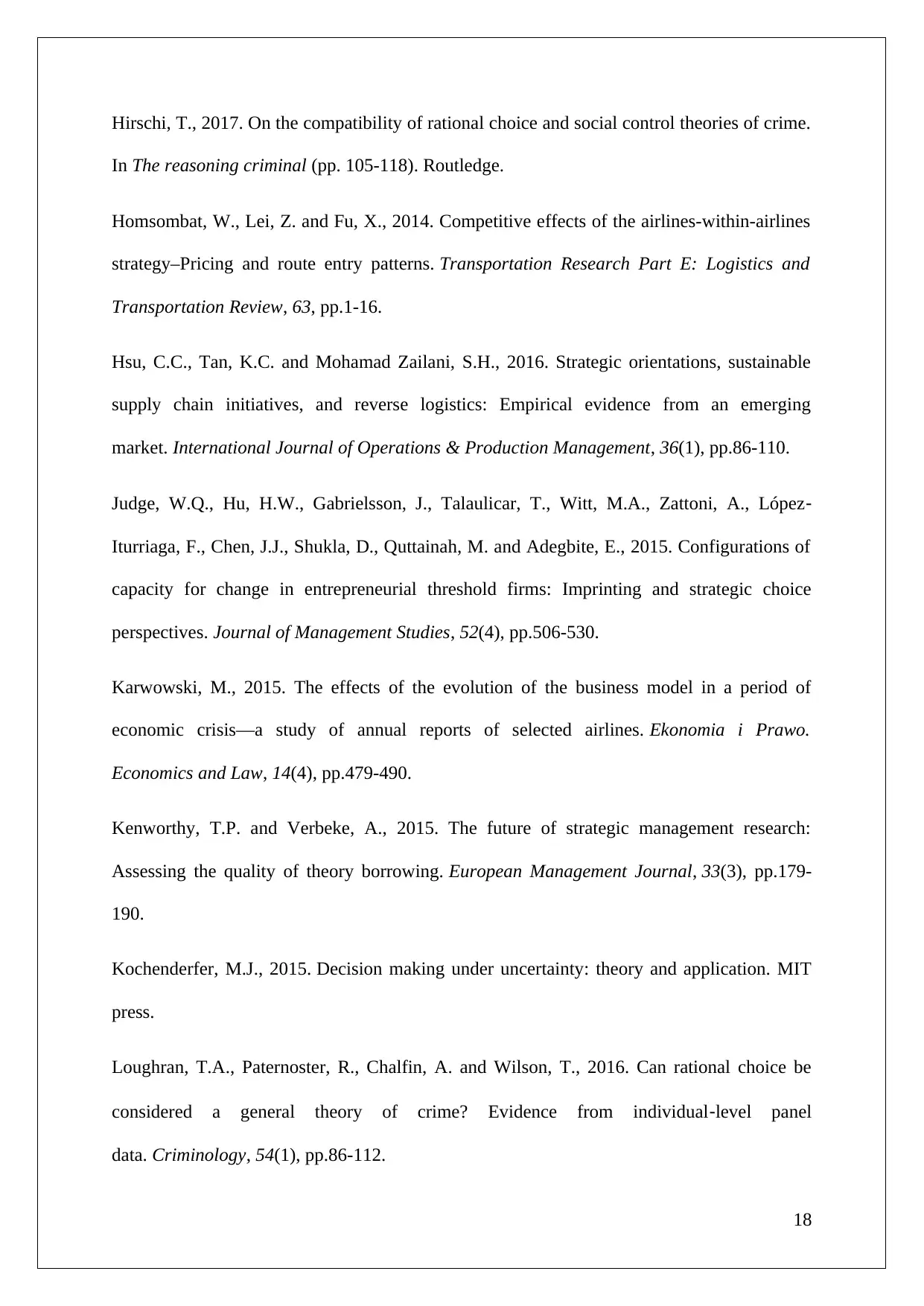
Hirschi, T., 2017. On the compatibility of rational choice and social control theories of crime.
In The reasoning criminal (pp. 105-118). Routledge.
Homsombat, W., Lei, Z. and Fu, X., 2014. Competitive effects of the airlines-within-airlines
strategy–Pricing and route entry patterns. Transportation Research Part E: Logistics and
Transportation Review, 63, pp.1-16.
Hsu, C.C., Tan, K.C. and Mohamad Zailani, S.H., 2016. Strategic orientations, sustainable
supply chain initiatives, and reverse logistics: Empirical evidence from an emerging
market. International Journal of Operations & Production Management, 36(1), pp.86-110.
Judge, W.Q., Hu, H.W., Gabrielsson, J., Talaulicar, T., Witt, M.A., Zattoni, A., López‐
Iturriaga, F., Chen, J.J., Shukla, D., Quttainah, M. and Adegbite, E., 2015. Configurations of
capacity for change in entrepreneurial threshold firms: Imprinting and strategic choice
perspectives. Journal of Management Studies, 52(4), pp.506-530.
Karwowski, M., 2015. The effects of the evolution of the business model in a period of
economic crisis—a study of annual reports of selected airlines. Ekonomia i Prawo.
Economics and Law, 14(4), pp.479-490.
Kenworthy, T.P. and Verbeke, A., 2015. The future of strategic management research:
Assessing the quality of theory borrowing. European Management Journal, 33(3), pp.179-
190.
Kochenderfer, M.J., 2015. Decision making under uncertainty: theory and application. MIT
press.
Loughran, T.A., Paternoster, R., Chalfin, A. and Wilson, T., 2016. Can rational choice be
considered a general theory of crime? Evidence from individual‐level panel
data. Criminology, 54(1), pp.86-112.
18
In The reasoning criminal (pp. 105-118). Routledge.
Homsombat, W., Lei, Z. and Fu, X., 2014. Competitive effects of the airlines-within-airlines
strategy–Pricing and route entry patterns. Transportation Research Part E: Logistics and
Transportation Review, 63, pp.1-16.
Hsu, C.C., Tan, K.C. and Mohamad Zailani, S.H., 2016. Strategic orientations, sustainable
supply chain initiatives, and reverse logistics: Empirical evidence from an emerging
market. International Journal of Operations & Production Management, 36(1), pp.86-110.
Judge, W.Q., Hu, H.W., Gabrielsson, J., Talaulicar, T., Witt, M.A., Zattoni, A., López‐
Iturriaga, F., Chen, J.J., Shukla, D., Quttainah, M. and Adegbite, E., 2015. Configurations of
capacity for change in entrepreneurial threshold firms: Imprinting and strategic choice
perspectives. Journal of Management Studies, 52(4), pp.506-530.
Karwowski, M., 2015. The effects of the evolution of the business model in a period of
economic crisis—a study of annual reports of selected airlines. Ekonomia i Prawo.
Economics and Law, 14(4), pp.479-490.
Kenworthy, T.P. and Verbeke, A., 2015. The future of strategic management research:
Assessing the quality of theory borrowing. European Management Journal, 33(3), pp.179-
190.
Kochenderfer, M.J., 2015. Decision making under uncertainty: theory and application. MIT
press.
Loughran, T.A., Paternoster, R., Chalfin, A. and Wilson, T., 2016. Can rational choice be
considered a general theory of crime? Evidence from individual‐level panel
data. Criminology, 54(1), pp.86-112.
18
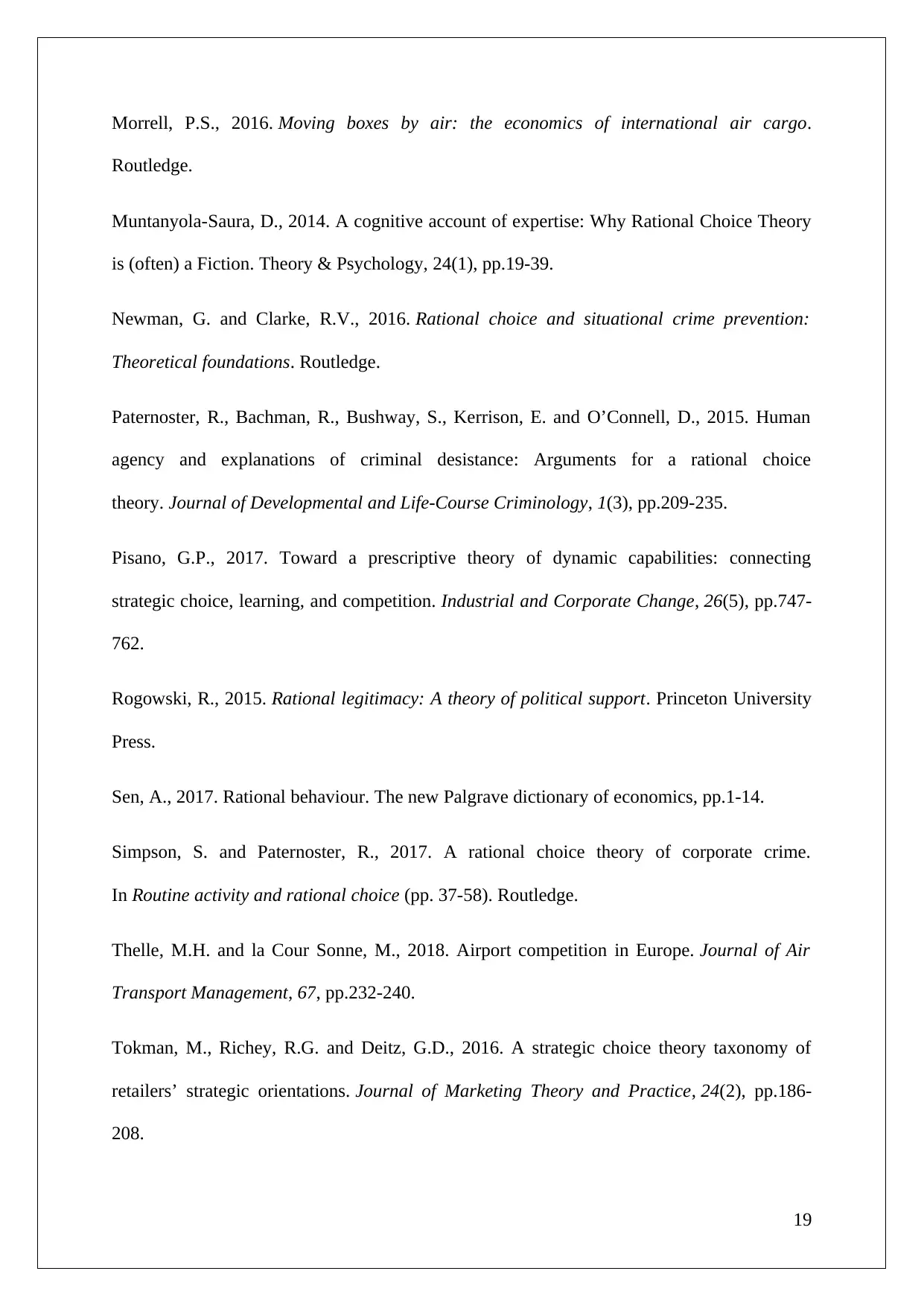
Morrell, P.S., 2016. Moving boxes by air: the economics of international air cargo.
Routledge.
Muntanyola-Saura, D., 2014. A cognitive account of expertise: Why Rational Choice Theory
is (often) a Fiction. Theory & Psychology, 24(1), pp.19-39.
Newman, G. and Clarke, R.V., 2016. Rational choice and situational crime prevention:
Theoretical foundations. Routledge.
Paternoster, R., Bachman, R., Bushway, S., Kerrison, E. and O’Connell, D., 2015. Human
agency and explanations of criminal desistance: Arguments for a rational choice
theory. Journal of Developmental and Life-Course Criminology, 1(3), pp.209-235.
Pisano, G.P., 2017. Toward a prescriptive theory of dynamic capabilities: connecting
strategic choice, learning, and competition. Industrial and Corporate Change, 26(5), pp.747-
762.
Rogowski, R., 2015. Rational legitimacy: A theory of political support. Princeton University
Press.
Sen, A., 2017. Rational behaviour. The new Palgrave dictionary of economics, pp.1-14.
Simpson, S. and Paternoster, R., 2017. A rational choice theory of corporate crime.
In Routine activity and rational choice (pp. 37-58). Routledge.
Thelle, M.H. and la Cour Sonne, M., 2018. Airport competition in Europe. Journal of Air
Transport Management, 67, pp.232-240.
Tokman, M., Richey, R.G. and Deitz, G.D., 2016. A strategic choice theory taxonomy of
retailers’ strategic orientations. Journal of Marketing Theory and Practice, 24(2), pp.186-
208.
19
Routledge.
Muntanyola-Saura, D., 2014. A cognitive account of expertise: Why Rational Choice Theory
is (often) a Fiction. Theory & Psychology, 24(1), pp.19-39.
Newman, G. and Clarke, R.V., 2016. Rational choice and situational crime prevention:
Theoretical foundations. Routledge.
Paternoster, R., Bachman, R., Bushway, S., Kerrison, E. and O’Connell, D., 2015. Human
agency and explanations of criminal desistance: Arguments for a rational choice
theory. Journal of Developmental and Life-Course Criminology, 1(3), pp.209-235.
Pisano, G.P., 2017. Toward a prescriptive theory of dynamic capabilities: connecting
strategic choice, learning, and competition. Industrial and Corporate Change, 26(5), pp.747-
762.
Rogowski, R., 2015. Rational legitimacy: A theory of political support. Princeton University
Press.
Sen, A., 2017. Rational behaviour. The new Palgrave dictionary of economics, pp.1-14.
Simpson, S. and Paternoster, R., 2017. A rational choice theory of corporate crime.
In Routine activity and rational choice (pp. 37-58). Routledge.
Thelle, M.H. and la Cour Sonne, M., 2018. Airport competition in Europe. Journal of Air
Transport Management, 67, pp.232-240.
Tokman, M., Richey, R.G. and Deitz, G.D., 2016. A strategic choice theory taxonomy of
retailers’ strategic orientations. Journal of Marketing Theory and Practice, 24(2), pp.186-
208.
19
Paraphrase This Document
Need a fresh take? Get an instant paraphrase of this document with our AI Paraphraser
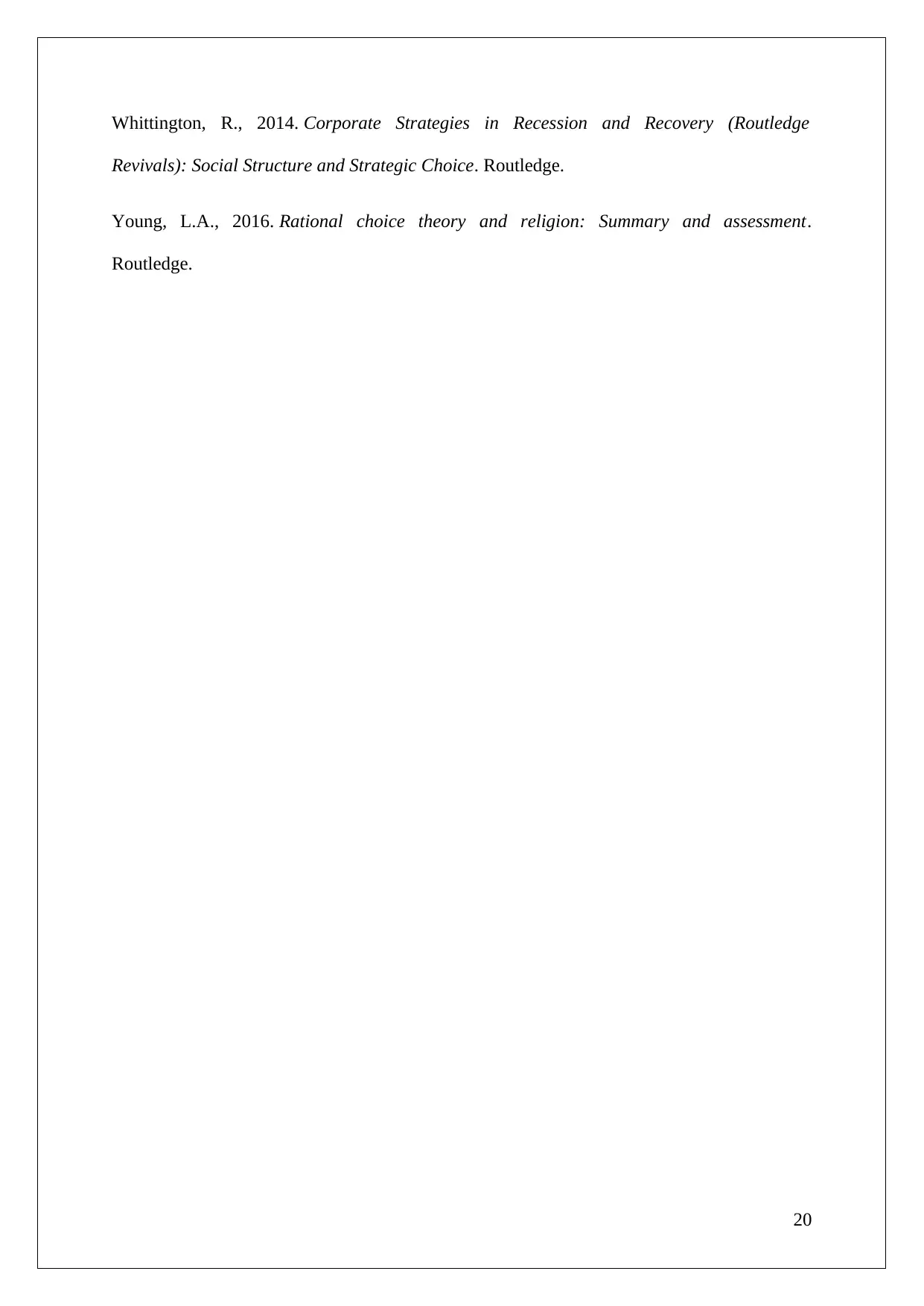
Whittington, R., 2014. Corporate Strategies in Recession and Recovery (Routledge
Revivals): Social Structure and Strategic Choice. Routledge.
Young, L.A., 2016. Rational choice theory and religion: Summary and assessment.
Routledge.
20
Revivals): Social Structure and Strategic Choice. Routledge.
Young, L.A., 2016. Rational choice theory and religion: Summary and assessment.
Routledge.
20
1 out of 20
Related Documents
Your All-in-One AI-Powered Toolkit for Academic Success.
+13062052269
info@desklib.com
Available 24*7 on WhatsApp / Email
![[object Object]](/_next/static/media/star-bottom.7253800d.svg)
Unlock your academic potential
© 2024 | Zucol Services PVT LTD | All rights reserved.




